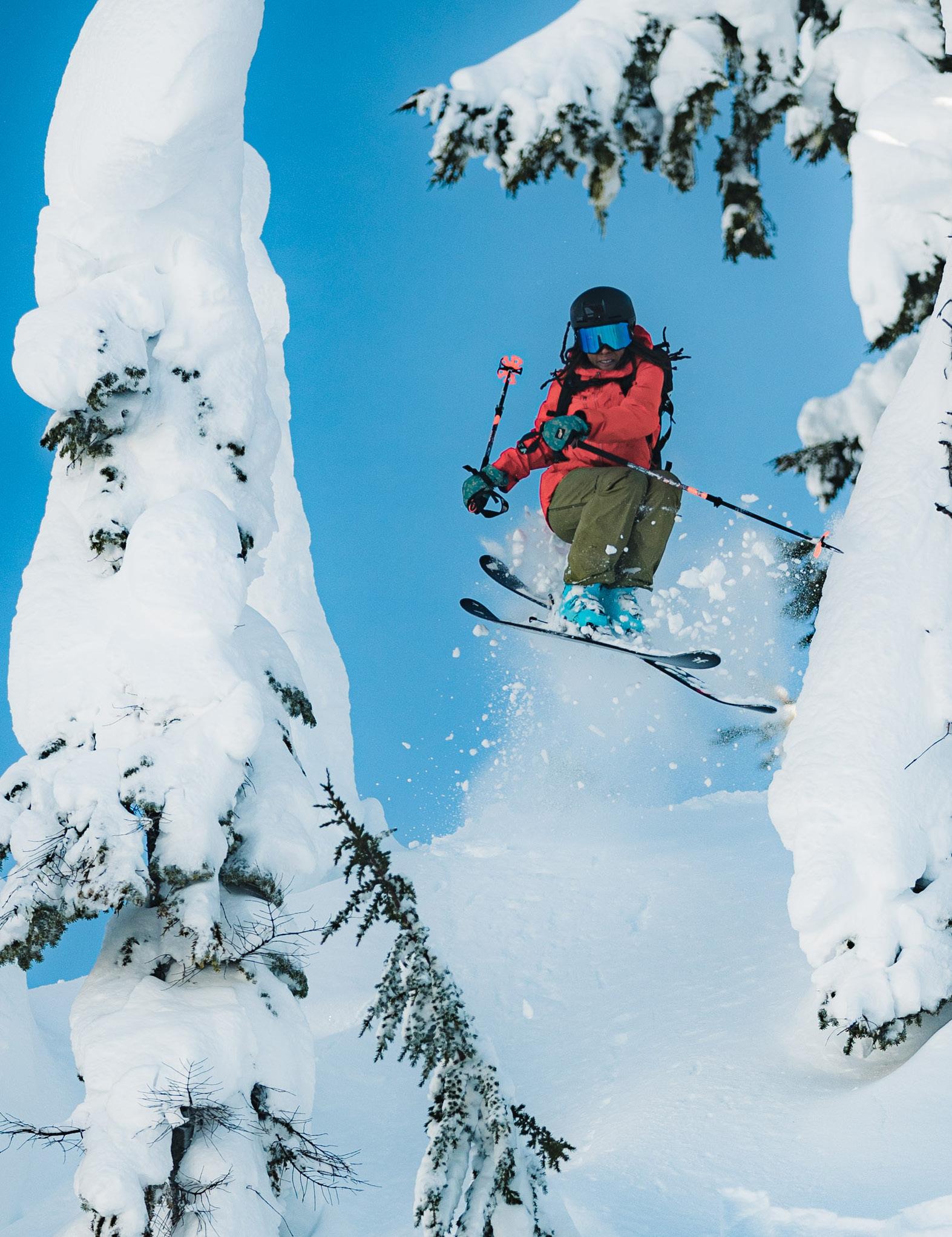

ICE BARS | ESTES PARK ESCAPE | SOAK AND SKI ELEVATIONOUTDOORS.COM WINTER 2022–23 FREE! Artist on the Slopes Brooklyn Bell Breaks Out THE ANGEL OF THE GRAND TRAVERSE BEST BACKCOUNTRY SWAG Stay in Control Preventing Tragedy on the Slopes
In Granby, everything’s a little more independent. That’s how you end up with a place like Two Pines Supply. Two Pines is a local outdoor outfitter carrying everything you need to ski, bike, camp, hike, and generally enjoy everything the mountains have to offer. That, and they also sell bulk spices, laundry refills, and safety third shirts. It’s not what you’ll find everywhere, but that’s kinda the point.
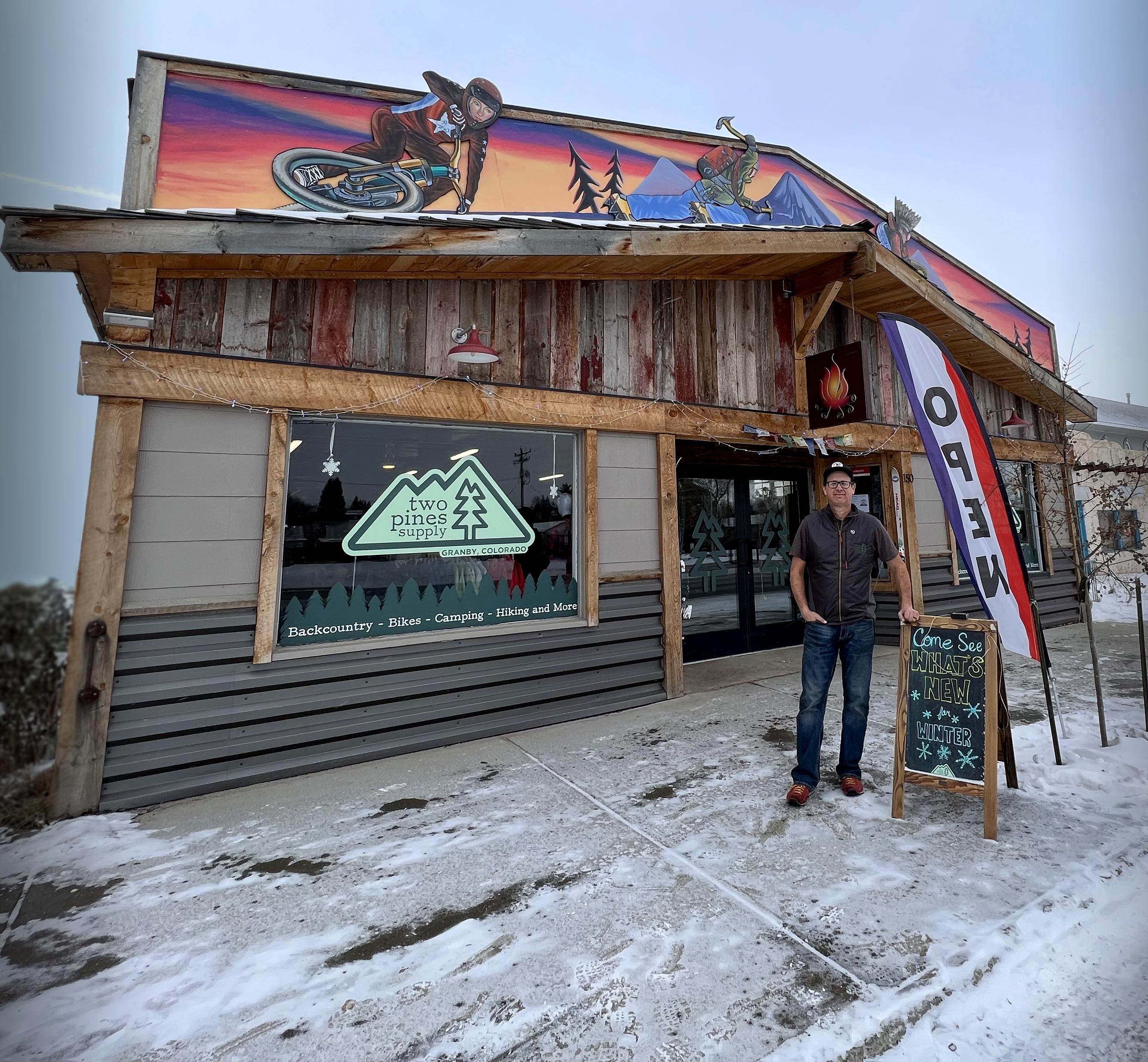
GRANBY. A LITTLE MORE INDEPENDENT.
Be a part of the longest-running ice fishing tournament west of the Mississippi on January 27-30. Ice fish on beautiful Lake Granby, Shadow Mountain Reservoir, and Grand Lake and vie for tens of thousands of dollars in cash and prizes.

DESTINATIONGRANBY.COM

IN THIS ISSUE
WINTER 2022-23
IS HERE: Elevation Outdoors contributors spend a lot of time playing outside in the wild, on the slopes, and on the skin track. Here’s the gear they can’t live without.

DEPARTMENTS 17 HOT SPOT
7
EDITOR’S LETTER
There’s a lot that watching birds can teach us about the long reach of time and how we should continue to share this planet with other species.
9
QUICK HITS
Baring it all in Full Frontal Freedom; the artist who remade Aspen; Colorado’s backcountry hot springs; close-tohome adventure in Estes Park; cleaning up plastic in the national parks; snowmobile safety, Jeremy Jones and the art of shralpanism; and much, much more.
14
Ski pow at Wolf Creek and soak at Pagosa Springs, where sitting in hot water is far more than an aprés activity.
18
STRAIGHT TALK
An artist, a professional mountain biker, and now a professional skier, Brooklyn Bell has been out here. In the film Becoming Ruby J, she created a Black femme character to live up to— now she is living that life.
30
ELWAYVILLE
grief threatened to paralyze her. Then she decided to take on the Grand Traverse ski race—without knowing if or how it would help.
24
BEST GEAR FOR THE BACKCOUNTRY

It’s shaping up to be an incredible snow year across the West. Here’s the best new gear that will help you enjoy the untracked and stay safe in the backcountry.
25
FLASHPOINT
The tragic death of skiing legend Ron LeMaster in a blindside collision has brought up questions about safety and personal responsibility at ski resorts. Do we need to do more?
President Biden declared a new Camp HaleContinental Divide National Monument this fall, honoring both the Ute people and the soldiers who trained here and gave everything.
FEATURES
21 BACK TO BREATH
When Chris Kassar’s sister died of cancer,
THE
2023
WINTER PEAK GEAR AWARDS
It’s time to hand out our coveted hardware to the best stuff we put to the test out in the wild—and keep using every day.
ON THE COVER
Featured in the films The Approach and Being Ruby J and sponsored by Faction, Brooklyn Bell is becoming the inspiration for a new generation.
Photo by Matt Roebke mattroebke.com
Instagram @mattroebke
ELEVATION OUTDOORS / WINTER 2022–23 4
WANT MORE? CATCH UP ON PAST ISSUES, YOUR FAVORITE BLOGGERS, AND DAILY ONLINE CONTENT AT ELEVATIONOUTDOORS.COM.
PEAK GEAR
ANDREW KORNYLAK
History. Heritage. Craft CULTURE. The Great Outdoors. Your Ticket to the Wild West.
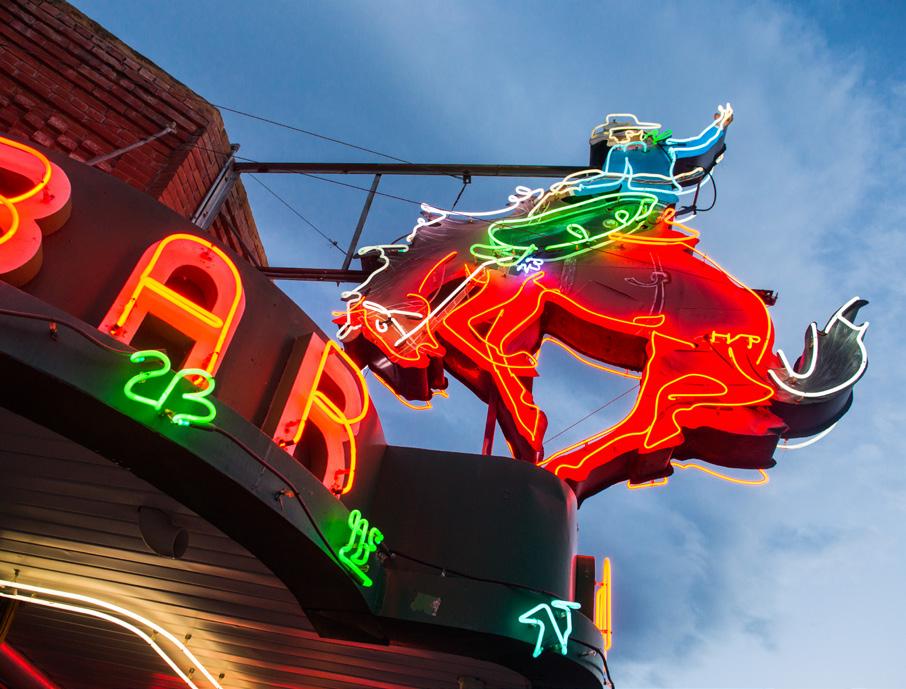





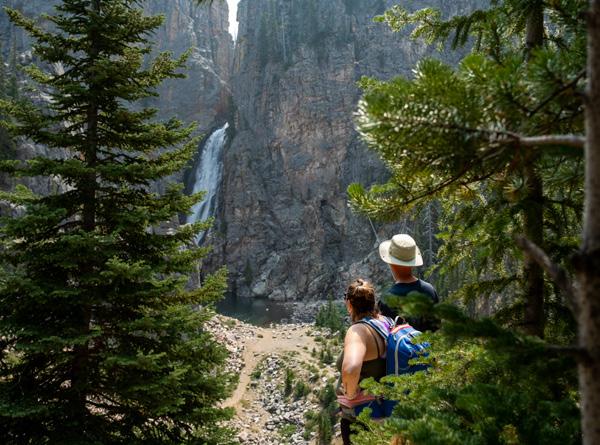



The world comes out west expecting to see cowboys driving horses through the streets of downtown; pronghorn butting heads on windswept bluffs; clouds encircling the towering pinnacles of the Cloud Peak Wilderness; and endless expanses of wild, open country. These are some of the fibers that have been stitched together over time to create the patchwork quilt of Sheridan County’s identity, each part and parcel to the Wyoming experience. Toss in a historic downtown district, with western allure, hospitality and good graces to spare; a vibrant art scene; bombastic craft culture; a robust festival and events calendar; small town charm from one historic outpost to the next; and living history on every corner, and you have a golden ticket to the adventure of a lifetime.
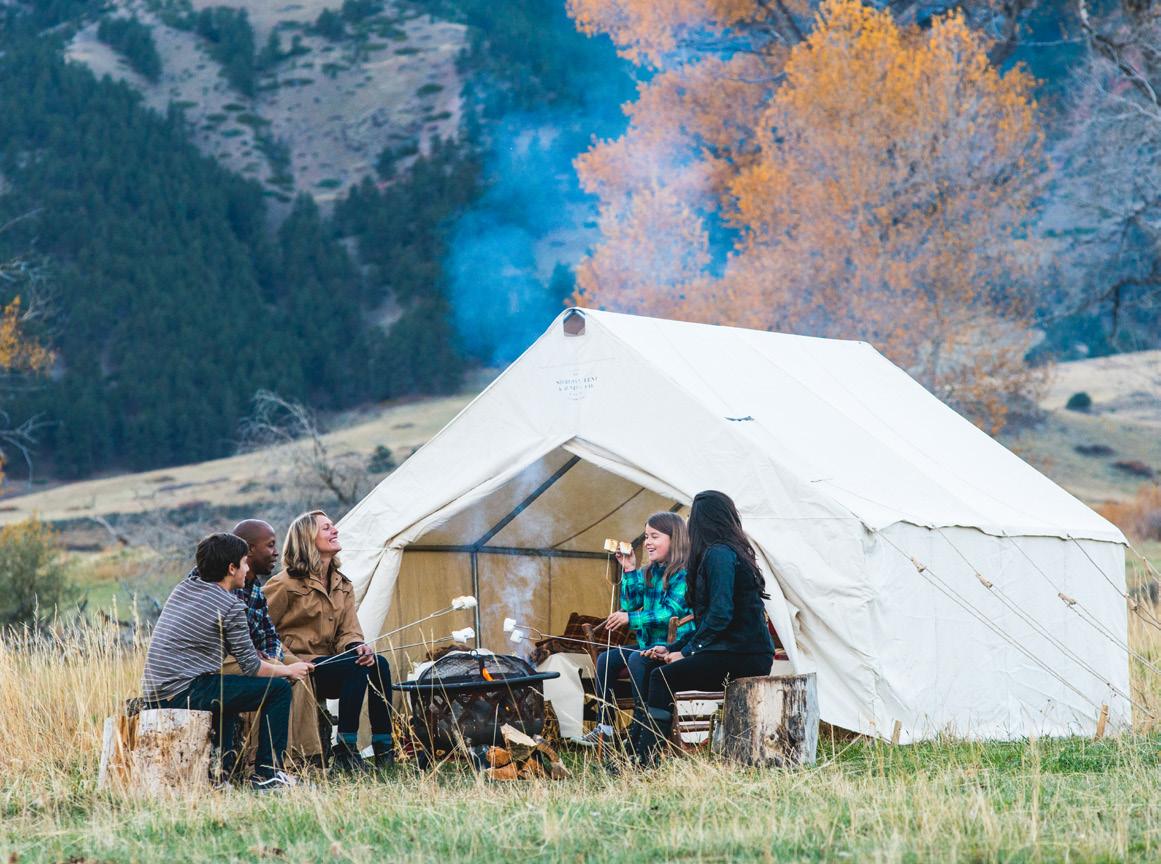
sheridanwyoming.org @VisitSheridan
EDITOR-IN-CHIEF DOUG SCHNITZSPAHN doug@elevationoutdoors.com
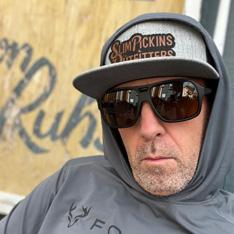


PRESIDENT / PUBLISHER BLAKE DEMASO blake@blueridgeoutdoors.com
CREATIVE DIRECTOR MELISSA KENNELLY m.kennelly@blueridgeoutdoors.com
EDITORIAL + PRODUCTION

MANAGING EDITOR CAMERON MARTINDELL cameron@elevationoutdoors.com
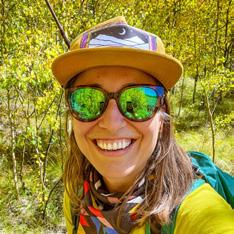

DEPUTY EDITOR TRACY ROSS
SENIOR EDITOR CHRIS KASSAR
COPY EDITOR MELISSA HOWSAM
EDITOR-AT-LARGE PETER KRAY
CONTRIBUTING EDITORS AARON BIBLE, ROB COPPOLILLO, LIAM DORAN, JAMES DZIEZYNSKI, HUDSON LINDENBERGER, DANI REYES-ACOSTA, CHRIS VAN LEUVEN
CONTRIBUTING WRITERS JILL ADLER, JEFF BLUMENFELD, WILL BRENDZA, LUCIE HANES, COURTNEY HOLDEN, SARAH KUTA, RADHA MARCUM, ARIELLA NARDIZZI, ENDRIA RICHARDSON
DESIGNER/ART MANAGE R REBECCA CENCEWIZKI art@blueridgeoutdoors.com
ADVERTISING + BUSINESS
ASSOCIATE PUBLISHER HANNAH COOPER hannah@elevationoutdoors.com
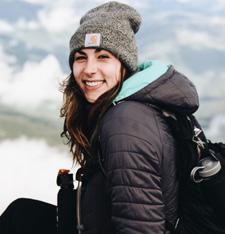
SENIOR ACCOUNT EXECUTIVE MARTHA
DOUG SCHNITZSPAHN I want to continue to try to listen better—to the trees, the planet, and to people. Deep listening creates real action.
HANNAH COOPER
Big changes can seem unattainable. I'm going to make small consistent changes to lower my carbon impact, like growing more of my own food and consuming fewer animal products.

CAMERON MARTINDELL
With the kids getting bigger, so are the adventures. We're going to step it up in skiing, biking, and camping (maybe more rafting too)!
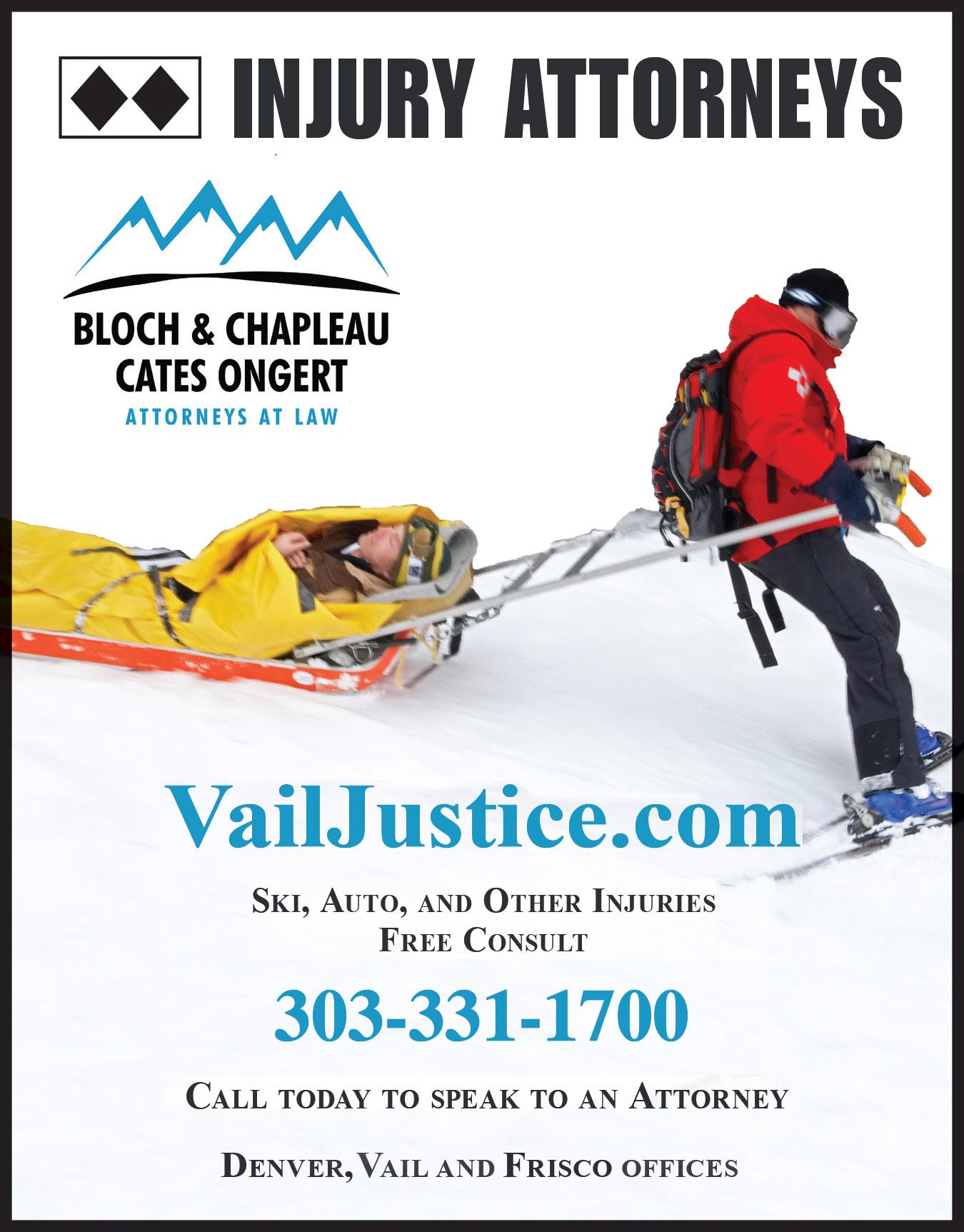
RYAN SCAVO
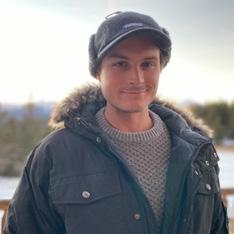
Ride more, ride harder, and (hopefully) ride faster; 2023 is all about exploring gravel in new places and who I am as a rider.
ENDRIA RICHARDSON
I am hoping to use less plastic and avoid down products in 2023. A small change, but hopefully one with bighearted implications. And while I'm at it, I hope to complete a revision of my novel in progress.
CHRIS KASSAR
The last couple years have been rough—for me, for our world, for so many of us. In 2023, I'm going to leave fear behind and focus on joy—finding it, being it, spreading it, sharing it, and helping others find theirs.
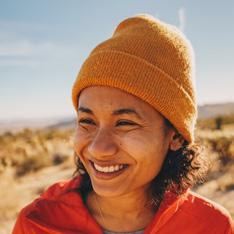


WILL BRENDZA
I hope that I can be happier. Not because I’m sad, but because I think happier is probably always better. That, and I want to sauna more. Because saunas are great.
AARON BIBLE
I continue to learn to be grateful for what I have—even if I'm not skiing 100 days a year.

ARIELLA NARDIZZI
I will embrace the unknowns and letting my writing and outdoor pursuits take me wherever they may.
PETER KRAY
Worry less. Do more. Especially for nature and our beautiful planet.
#channelingstfrancis
ELEVATION OUTDOORS / WINTER 2022–23 6
Recycled Apparel
Our
Supply
100%
Made Within
HyperLocal
Chain. Tell your sustainability story with Recover. We offer a variety of wholesale programs from blanks to custom design & print. Contact us for a quote. recoverbrands.com
CIRCULATION INQUIRIES circulation@elevationoutdoors.com DIGITAL MEDIA ONLINE DIRECTOR CRAIG SNODGRASS DIGITAL EDITOR RYAN MICHELLE SCAVO PUBLISHED BY
Summit Publishing, LLC. ALL RIGHTS RESERVED
PUBLISHING
EVANS martha@elevationoutdoors.com BUSINESS MANAGER MELISSA GESSLER melissa@elevationoutdoors.com
©2022
SUMMIT
What big change—in yourself, in the world—do you hope to make in 2023?
CONTRIBUTORS | 12.22
HALF EARTH?

WE HAVE A LOT TO LEARN FROM BIRDS (AND FROM WATCHING THEM) ABOUT OUR OWN SPECIES AND THE SURVIVAL OF OUR PRECIOUS PLANET.
by DOUG SCHNITZSPAHN
We leave Santa Fe before 4 a.m. to make it to Bosque del Apache for the big show. The temperature is in the 20s by the time we reach the wildlife sanctuary on the Rio Grande south of Albuquerque—but it feels even colder—and birdwatchers are already lined up along a pond just north of the visitors center where thousands of snow geese and sandhill cranes are roosting, squawking, and taking to the air in the faint light of predawn and a waning sliver of moon. As the sun begins to rise, more birds come in, just visible in formation high in the sky. They land on the ever-crowding pond as others take off, the white of the geese and long necks of the cranes standing out against the mountains of the Chupadera wilderness. It was worth the early morning (or still night) drive to see this spectacle—one that predates our own species’ sense of time.
It’s a powerful reminder that this planet is not just ours. In fact, despite our ability to travel beyond it (on the radio on the drive down we heard that the U.S. plans to build a permanent base on that moon dipping below the horizon), we are just a small part of its much larger picture—although we have evolved, almost unnaturally, to the point where we could forever warp its subtle, inexorable beauty.
In his book The Social Conquest of Earth, which I consider required reading for anyone who wants to better understand our place among the species and evolution of this planet, biologist EO Wilson observes: “Humanity today is like a waking dreamer, caught between the fantasies of sleep and the chaos of the real world. The mind seeks but cannot find the precise place and hour. We
have created a Star Wars civilization, with Stone Age emotions, medieval institutions, and godlike technology. We thrash about. We are terribly confused by the mere fact of our existence, and a danger to ourselves and to the rest of life.”

Watch birds in a place like this and those words serve as a reminder of the great responsibility we have to ensure this spectacle continues despite our best efforts to expunge the Earth of anything beyond our own ever-hungry technology.

Sandhill cranes are ancient. The fossil record proves they have flown and found mates for life for at least 2 million years. Our own species is only about 300,000 years old. Stand in the dawn and watch them fly and you glimpse the primordial past—or eternity. And they do feel prehistoric— seemingly awkward, but graceful when they walk or take wing. For me personally, they are special birds too. I first saw a mating pair while I was working for the Forest Service back on the West Fork of Montana’s Madison River. They would fly and call each morning as we went to work building trails, away from any news of the world, and made us feel more connected to—and in wonder of—the mountains around us. These ancient creatures make me feel at peace in the hectic sprawl of our human world and my own being.
Wilson also wrote about the need to share—and the possibility of sharing— this planet with the at least 8.7 million species that inhabit it. He proposed the idea of “Half Earth,” of setting aside 50% of it for them
That seems like a moral imperative when we actually get out and observe at least some of those species in their world. I suggest that you stop your routine—for at least a little while—and look around.
WINTER 2022–23 / ELEVATIONOUTDOORS.COM 7
DOUG SCHNITZSPAHN
TAKING FLIGHT: SNOW GEESE AND SANDHILL CRANES CONTINUE THEIR PRIMORDIAL PATTERN OF MIGRATION AT NEW MEXICO'S BOSQUE DEL APACHE WILDLIFE REFUGE.
EDITOR'S LETTER | 12.22
Classics
One is Glen Plake, the legendary Freeskiing icon, and the other is the Patrol 3D glove from the LEKI Classics collection. www.leki.com

 PATROL 3D
Photo: Grant Gundeson
PATROL 3D
Photo: Grant Gundeson
FROM HEMLINES TO RIDGELINES
FULL FRONTAL FREEDOM BARES IT ALL.
BORN FROM A “DESIRE TO unite all rebels, the overlooked, and the renegades” of the winter world, Full Frontal Freedom is the new short film from Coloradobased Wild Barn Coffee.
In 2021, the company spread word of a naked ski lap secretly happening after hours at a resort. That day, women and genderqueer individuals were invited to a remote backcountryonly resort to connect over tacos and live music, and to participate in the world’s largest naked ski lap. The result? The launch of Boot Tan Fest, the largest all-female backcountry ski and snowboard festival on the planet—27 women skinning uphill in costumes and ski kits, and theN baring it all and skiing down. For the second annual event, the participants grew tenfold, with over 200 women stripping down on top of the peak and skiing a full backcountry lap bare naked. This is when Full Frontal Freedom was born.

With a goal of shifting focus from “hemlines to ridgelines,” according to Jenny Verrochi, co-founder of Wild Barn Coffee and Boot Tan Fest, “the event literally and figuratively strips us down, encouraging a feeling of unbridled collective joy. On top
of that peak, amidt ripping skins and shedding layers, a feeling of collective freedom rippled through the naked crowd. The last few years have been especially hard on women. So this space, this event, this day, is for us–and Full Frontal Freedom captures it all.”
View the Full Frontal Freedom trailer on the Wheelie YouTube channel, and mark your calendars for March 13–14 to join next year’s Boot Tan Fest.
—Ryan Michelle Scavo
his wife’s urging and set out to change Aspen’s ragtag persona. Understanding the region’s unparalleled natural beauty, he began to invest heavily in the quiet town with an overarching goal of making it a world-class destination for skiing and other outdoor pursuits, arts and culture, and more.
GOOD GESAMTKUNSTWERK
MEET HERBERT BAYER, THE ARTIST WHO HELPED PUT ASPEN ON THE MAP.
THOUGH TODAY ASPEN IS a well-known four-season playground attracting highprofile visitors from around the world, it wasn’t always this way. In the first few decades of the 1900s, by contrast, the Roaring Fork Valley town was a sleepy ranching community full of rundown buildings and abandoned silver mines.
After World War II, a wealthy Chicago businessman named Walter Paepcke visited Aspen at
For help, he turned to a gifted artist named Herbert Bayer. In the nearly 30 years Bayer spent in Aspen, from 1946 to 1974, he left an indelible mark on the community— and ultimately helped make it the popular destination it is today.
The late artist’s legacy takes center stage at the new Resnick Center for Herbert Bayer Studies, a free museum and community gathering space that opened over the summer on the grounds of the Aspen Institute (which Bayer himself designed).
“Bayer was instrumental in Aspen’s postwar revitalization,” says Lissa Ballinger, the center’s acting director. “He had a profound influence on the making of modern Aspen, on the development of Aspen as a cultural and recreational destination.”
Born in Austria in 1900, Bayer studied and taught at
the famed Bauhaus school that operated in Germany from 1919 to 1933, which prioritized simplicity, efficiency, and practicality—such as primary colors and basic shapes—in art and design. Training and natural talent combined to make Bayer a prolific polymath, skilled in everything from painting to architecture to sculpture to advertising and graphic design.
It took a little convincing to get Bayer to move to Aspen— at the time, the town was remote, unknown, and had just 800 residents, after all—but, eventually, he agreed. When he arrived, Bayer quickly got to work breathing new life into the neglected town. He restored the longstanding Hotel Jerome to its former glory, renovated the historic Wheeler Opera House twice, and developed the Aspen Skiing Company’s instantly recognizable logo. He created clever advertising campaigns to entice tourists to visit Aspen and designed the first Sundeck atop Aspen Mountain.
But his gesamtkunstwerk, or total work of art, was the Aspen Institute campus. Bayer spent 20 years carefully designing every aspect of the 40-acre site, which today continues to host important cultural events like the Aspen
WINTER 2022–23 / ELEVATIONOUTDOORS.COM 9 QUICK HITS | 12.22
WHEELIE COURTESY WILD BARN COFFEE
Ideas Festival and the Aspen Music Festival.
See for yourself on a trip to Aspen this winter: Wander through the new center’s inaugural exhibition, Herbert Bayer: An Introduction or take a guided tour of its galleries. Book a room at Aspen Meadows Resort, also on the grounds of the Aspen Institute, and marvel at Bayer’s art installations and the rolling hills, called “earthworks,” he integrated into the landscape. Sip white hot chocolate with housemade red, blue, and yellow marshmallows at the on-site restaurant, Plato’s. And when you hit the slopes at Ajax, Snowmass, Buttermilk, or Aspen Highlands, pay a little extra attention to the leafshaped outlines you see all over the hill—it’s Bayer’s stamp, left everywhere.
 —Sarah Kuta
—Sarah Kuta
SOAKING SANCTUARIES
IF YOU’VE ALWAYS DREAMED of relaxing in a steaming mineral pool overlooking a rushing river amidst the deep valleys and snowcapped peaks of this beautiful state, here’s your jam: We give you four of the best backcountry hot springs in Colorado.

Of course, getting to these special spots requires a little bit of walking. It is important to note that, while a post-ski soak in one of these springs would be a dream-cometrue, avalanche hazards also become prevalent, and many of the roads may be inaccessible to vehicles in the winter. Always do your research on the best season to recreate in these backcountry destinations.
Rainbow Hot Springs
Located along the San Juan River, the 7-mile round-trip hike here is worth the journey on its own. The trail takes you past picturesque waterfalls, through thick forest, and over old wooden bridges to a collection of two main pools right at the river’s edge. This is one of the most isolated hot springs on our list, but the seclusion and reward of soaking your weary muscles after a 4.5-mile hike makes it a must-visit on any lis t.
Conundrum Hot Springs Situated in the Maroon BellsSnowmass Wilderness, these hot springs sit at a lofty 11,200 feet above sea level. The strenuous 17-mile round trip hike is nothing to scoff at and takes you through difficult terrain at high elevation. The trail is typically backpacked as a twoday trip and requires obtaining a permit from recreation. gov due to the fragile nature of this ecosystem. However, Conundrum’s springs should be on everyone’s bucket list due to the jaw-dropping mountain scenery everywhere you look. The lengthy journey to get here will make these panoramic pools all the more enjoyable.
Radium Hot Springs Kremmling Don’t be fooled by the mileage! Although it’s only a short 1.4-mile out-and-back hike,
the trail is steep and direct, bringing you straight down to the mineral pools. These primitive springs are located right on the banks of the Colorado River, which typically cools down the temperature to about 80 degrees Fahrenheit. In fact, the pool gets washed out by snow melt each year and has to be rebuilt by visitors, so take caution when visiting in the spring.
Piedra River Hot Springs
Also known as the “Sheep Creek Hot Springs” by locals, these turquoise gems in the San Juan mountains range from a scalding 140 degrees to more moderate temperatures along the river. While many of the hot springs on this list draw their own large crowds, these pristine pools are reported to boast the most serenity and provide an escape from civilization on a 3-mile round trip hike.
—Ariella Nardizzi
TECHNOLOGY
CARDO PACKTALK
OUTDOOR
This inter-helmet Dynamic Mesh Communication system can be installed on nearly any helmet. The waterproof units actively seek to connect with each other, and will adapt based on the number of units, and will stay connected up to 3 miles apart. $250 | CARDOSYSTEMS.COM

GEAR WE LOVE BOOKS
KOMPERDELL CARBON FXP TEAM GREEN
This lightweight trail running/trekking pole puts itself together! Through a happy accident in the design process, just holding the handle and letting the other segments go, it all snaps into place. Stowing isn’t just automatic, but it’s easy as well. $220 | KOMPERDELL.COM

THE ART OF SHRALPINISM: LESSONS FROM THE MOUNTAINS
Jeremy Jones has spent a lot of time in the mountains, and he’s quick to admit he’s made mistakes and is grateful those mistakes didn’t cost him his life. His book—inspired by his love of shredding and alpinism—is full of his own art. In these 288 pages, he shares the lessons learned from his experience—so far. $30 | MOUNTAINEERSBOOKS.ORG

ELEVATION OUTDOORS / WINTER 2022–23 10
LEFT TO RIGHT: SARAH KUTA, DAN WEINENBERG
YOU CAN STILL FIND SOLITUDE IN THESE HOT GEOTHERMAL POOLS IN THE COLORADO BACKCOUNTRY.
EAT PLAY STAY: ESTES PARK, COLORADO
climbing, and backcountry ski trips to accommodate all levels of adventurers.
STAY
EAT
The gateway town to Rocky Mountain National Park, Estes Park is home to lots of great places to eat. But a relatively new addition is proving to be a standout dining experience. Located on US 36, the park entrance road, Bird & Jim ( birdandjim.com) easily fulfills its promise of “modern mountain dining.” As expected, the menu is driven by the availability of locally sourced ingredients and may evolve with the seasons. One of our favorites was the lamb Bolognese with pappardelle, garlic, whipped mascarpone, red wine, and, of course, ground lamb from a farm in nearby Longmont, Colorado.
PLAY
"
BUT A RELATIVELY NEW ADDITION IS PROVING TO BE A STANDOUT DINING EXPERIENCE.
LOCATED ON US 36, THE PARK ENTRANCE ROAD, BIRD & JIM EASILY FULFILLS ITS PROMISE OF “MODERN MOUNTAIN DINING”
While Rocky Mountain National Park ( nps.gov/romo) isn’t the only place to play, it certainly offers the most opportunity. Hiking is available all season long—with boots and traction spikes in the early season and snowshoes or skis when the snow is deep. Our adventure was in December and spikes were perfect. We hiked from Glacier Gorge to Sky Pond , about 4 miles each way. Our guide, Jesse Ramos, gave us a number of great options varying in length and effort so we could settle on this hike— the perfect one for us. Ramos and other guides working with the Estes Park-based Colorado Mountain School (coloradomountainschool.com) also offer rock climbing, ice
The Mountain Village at Lake Estes ( mountainvillageestespark .com) hosts a community of luxury cabins looking out on the lake or surrounding mountains, a stone fireplace to cozy up with a book or loved ones, and a hot tub on the deck for post-adventure relaxation. The modern kitchen is well appointed for in-house meals or just to keep the hot cocoa flowing. The cabins have two bedrooms, including a kingbed master on the second floor with a loft seating area when you can retreat away from any of the bustle happening downstairs. The first-floor bedroom with en suite gives another couple (or siblings able to share a king bed) a comfortable space of their own. For full-house guests, the sofa in front of the fireplace pulls out to a bed as well. Upon request, a festive holiday tree and decorations can be added to cater to the season. And, since Estes Park is such an intimate small town, everything is within a short drive.
—Cameron Martindell
LOCAL HERO: MIKE DUFFY
TOO MANY BACKCOUNTRY SNOWMOBILERS GET BY ON NOTHING BUT LUCK.
MOST SNOWMOBILERS NEW to the backcountry get by on luck rather than education about how to operate more
safely in avalanche zones. “When uneducated mountain snowmobilers tell me they’ve been riding in the backcountry for 20 years without an accident, I say, ‘Well, you’ve been lucky for 20 years,’” says Mike Duffy, the Eagle-based Certified American Avalanche Association course provider and instructor, and member of the Motorized Avalanche Professionals who has almost 30 years in avalanche education as founder of avalanche1.com
“The most common denominator in the motorized avalanche accidents I’ve studied is not a single operator has taken an on-snow class from an experienced instructor.”
There’s still a lot Duffy doesn’t know, especially after 2019, one of the biggest avalanche cycles in 500 years, which accumulated 120 feet in spots and wiped out 100-year-old buildings. The backcountry skier, kayaker, dirt biker, snowmobiler, and father of one son.
“Never stop learning, especially when traversing on or under 30- degree slopes, and never let your guard down,” he says. “Safely navigating the backcountry on a motorized vehicle is a lifelong learning process. The more you know, the better decisions you can
make. The knowledge we have now about avalanches compared to 15 years ago is much better.”
Studies reveal cellphones can adversely impact transceivers when used in the search mode. “Many inexperienced searchers wouldn’t know that,” says Duffy, who works with Backcountry Access. “Snow doesn’t provide the best feedback and can lead to a false sense of security. As we like to say in class, ‘Mother Nature always bats last.’
—Jeff Blumenfeld
ON THE ROCKS
THOUGH THE EXACT DETAILS
are a little murky, the saga of Vail’s legendary ice bar goes something like this: During one of the resort’s first seasons, investor Bill Whiteford piled up snow to form a chilly platform for eating and drinking right on the slopes.
Skiers embraced the concept immediately, gliding up for libations, pizza, crepes, pastrami, corned beef, and milkshakes. When the lifts stopped spinning, there was nowhere to lock up the ice bar’s beer and spirits, so
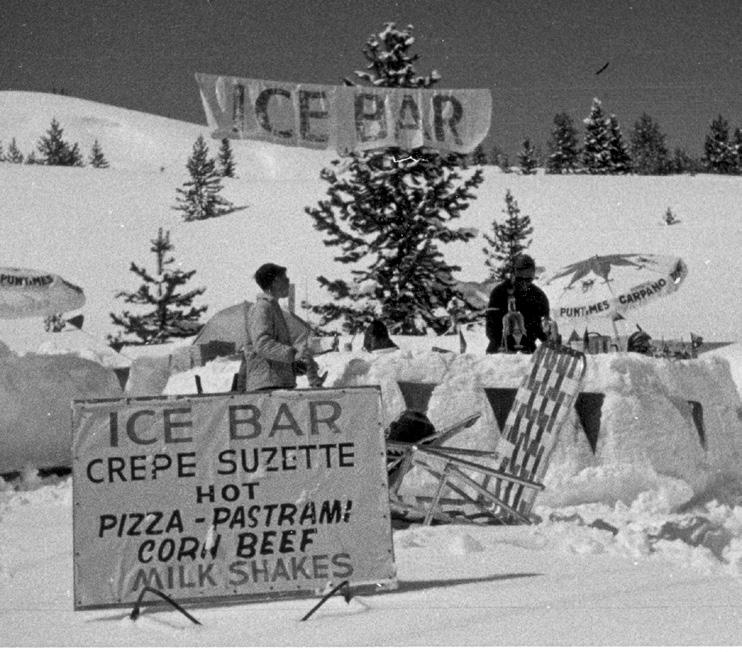
WINTER 2022–23 / ELEVATIONOUTDOORS.COM 11 COURTESY VAIL RESORTS
THE PERFECT WINTER GETAWAY IS AN EASY TRIP FOR FRONT RANGERS LOOKING FOR A WILD WEEKEND CLOS TO HOME.
VAIL IS BRINGING BACK ITS LEGENDARY ICE BARS.
resourceful ski patrollers often stopped by for a quick pick-me-up on their way home.
Founded in December 1962, Vail has grown to become one of the largest and best-known ski resorts in the world, attracting international travelers with its expansive "back bowls" and fluffy powder. To help celebrate 60 years in business, Vail is resurrecting Whiteford’s clever idea by opening two ice bars this season. One is located at Eagle’s Nest and can be accessed either via skis or from the nearby gondola; it also features four private snow bungalows. The other is situated at Wildwood.

“There’s a classic spirit at Vail Mountain that is unique, organic, and effortless that we’re trying to bring forward for our 60th anniversary,” says Beth Howard, the resort’s vice president and chief executive officer. “When we were looking at old photos, the ice bar really jumped out as an iconic symbol of what it means to be Vail Mountain.” —S.K.
A BETTER BLAME GAME
WHEN IT COMES TO POLLUTION,
everybody wants to play the blame game. Putting the onus on this entity or that manufacturer takes the burden off of our own shoulders. It’s true that corporations contribute far more to pollution rates than individuals. But without specifics to back that up, there’s no way to hold those corporations responsible and nowhere to direct our condemnations. Criticism can’t be constructive if it doesn’t have anywhere concrete to land.
Marcus Eriksen and Anna Cummins from the 5 Gyres Institute saw a way to make the blame game more productive. After the Department of the Interior announced the initiative
to phase out single-use plastic in national parks, the team at 5 Gyres started digging deeper. They knew not much could actually come of that decision without a better understanding of the source.

New research from their Plastic-Free Parks campaign reveals the worst offenders of plastic pollution throughout national parks all over the country. They pulled the
data from observations by park visitors, giving everyday outdoorsmen the chance to take their own piece of ownership over the project. The study calls out the most prevalent brands and items found on the scene as first targets.
The Marlboros and Coca-Colas of the world deserve to bear the blame. Now, thanks to 5 Gyres, we can finally prove it. 5gyres.org
—Lucie Hanes
UNLIMITED IKON ACCESS • 20 MILES WEST OF BOULDER
THE 5 GYRES INSTITUTE IS ON A MISSION TO CLEAN UP PLASTIC IN NATIONAL PARKS.
5 GYRES INSTITUTE
COURTESY
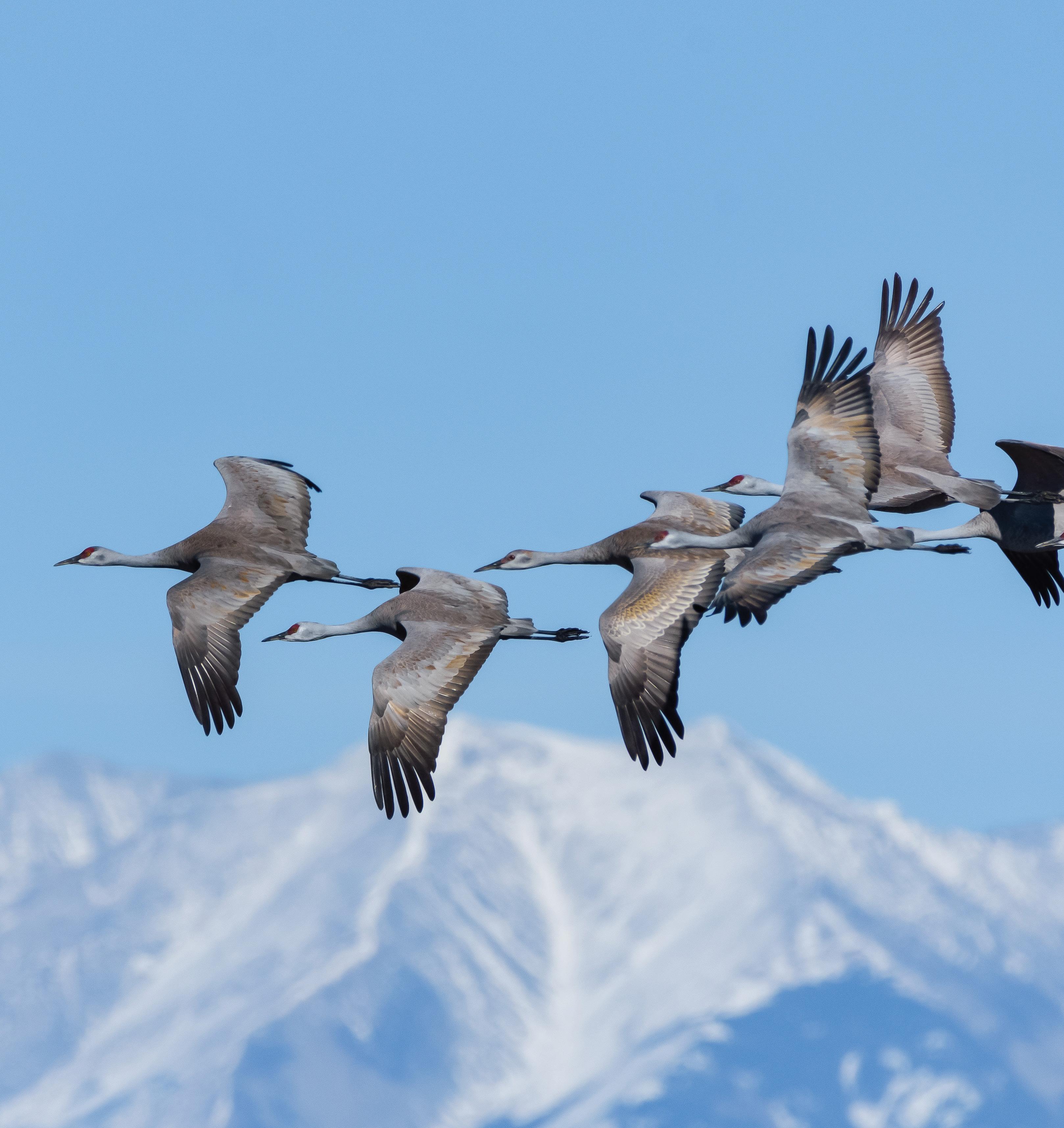
SAFER SLOPES
anyone up on the hill. LeMaster took off down Windmill, a blue run on the front side of Eldora, skiing perfectly as “The Master” always did. He never saw the snowboarder who collided with him. It happened in a split second. The impact was tremendous. It killed LeMaster almost instantly.
The fatality sent shockwaves through the snowsports community because Ron LeMaster was a skiing celebrity. He had coached the sport for over 30 years, partly with the U.S. National Ski Team, and he’d written several influential books on the sport, including Ultimate Skiing, and The Skier’s Edge
by WILL BRENDZA
It was a clear, warm, quiet early season day on Nov. 30, 2021, at Eldora. The Front Range ski area had been open for just 11 days. It was a weekday and there were very few people up on the mountain.
Ron LeMaster, 72, a world renowned ski coach, ski author, and ski photographer, had been up that morning photographing a ski team. But as the weather got warmer, and more people started to arrive, he put his camera away and turned to his friend, Gordon Reece.
“Better get home to my wife,” LeMaster said. “The circus has arrived.”
But it was still an extremely slow Tuesday with no new snow and barely
The man who hit him, Nicholas Martinez, 28, got up and attempted to flee the scene. But Reece took a cellphone photo of him. According to witnesses, Martinez then grabbed the phone before another bystander retrieved it from him. Martinez was gone before ski patrol arrived to find LeMaster motionless and bleeding.
No one would have known who he was if not for Eldora’s parking employees who caught him trying to drive away.
Since no one saw the collision, the police could not charge Martinez with anything more than a petty offense of leaving the scene, which carries a $1,000 fine—to which he has pleaded not guilty.
“In my mind, that’s essentially a slap on the hand with no investigation,” says Alexis LeMaster, Ron’s daughter. She says that she’s still dealing with a legal nightmare from her father’s death, even a year after the fact.
But the other reason Ron’s death made waves had nothing to do with who he was, what he accomplished, or how he died. It’s the same reason any accident at Eldora—or elsewhere in Boulder County makes hasty headlines. Any time the county Sheriff’s Office responds to a call in the county—whether it’s to an emergency rescue, a shooting, a traffic accident, a fire, or a fatality at Eldora— every resident who’s signed up for the emergency mass notification system receives a phone or text message, email, or notification (residents choose how they want this information when they sign up). And with the Sheriff’s Office’s news release system, media outlets quickly receive advisories.
Most other counties in ski country don’t have such a system. And without any kind of legal requirement for resorts to report injuries or fatalities that happen on their slopes, there’s a black hole surrounding in-bounds accidents. No one is publicly keeping track of those numbers on a year to year basis.
Some politicians and organizations like Safe Slopes Colorado (SSC), a nonprofit activist organization advocating for accident reporting, are trying to change that. In March of 2021, SSC helped Colorado Sens. Jessie Danielson and Tammy Story draft SB 184, the Ski Area Safety Plans and Accident Reporting bill. The bill made it onto the floor of the Colorado House and would have made it mandatory for ski resorts to track and report accidents, injuries, and fatalities.
SSC argues that this kind of transparency is necessary and the only way to truly make the slopes safer.
The resorts are not on board. They maintain that reporting accidents wouldn’t do anything to make people ski safer—that it would only cause potential visitors to be unreasonably afraid of the activity, despite their concerted efforts at keeping it safe and welcoming.
Do We Need More Transparency?
Ron LeMaster was the third death at Eldora in 2021. That calendar year, five skiers and boarders lost their lives in-bounds at the resort. It was Eldora’s

ELEVATION OUTDOORS / WINTER 2022–23 14
FLASHPOINT | 12.22
COURTESY ELDORA
THE
NEW SAFETY
REMIND
TO KEEP AWARE AND STAY
GETTING
WORD OUT: ELDORA’S
MASCOTS
SKIERS AND RIDERS
IN CONTROL.
THE TRAGIC DEATH OF RON LEMASTER IN A BLINDSIDE COLLISION HAS BROUGHT UP QUESTIONS ABOUT SAFETY AND PERSONAL RESPONSIBILITY AT SKI RESORTS. DO WE NEED MORE TRANSPARENCY?
“RON’S DEATH, AND THE OTHER TRAGIC ACCIDENTS WE'VE EXPERIENCED, INSPIRED US TO AMPLIFY OUR EXISTING SAFETY MESSAGING. WE CAME UP WITH SOME NEW WAYS TO SPREAD THE WORD.” —SAM BASS, ELDORA
(X2)
deadliest year to date, an unfortunate spate of tragic accidents that cast a shadow over the friendly 680-acre resort.
Alexis grew up skiing with her dad. He coached her the same way he’d coached professionals, and, naturally, she grew to love the sport. Her dad was one of the safest skiers she’d ever seen. He was always alert. He was always in control. And he actively avoided crowds—just as he was trying to do on the day he was killed by a dangerous rogue snowboarder.

That part freaks Alexis out the most. “If the person I know who is the most aware and cautious of his surroundings on the mountain, if he can be caught by surprise, anybody can,” she says.
Until recently we had no idea how often accidents like this occurred at Colorado ski areas. Even now, the numbers we have aren’t perfectly accurate or very up-to-date. In late 2020, for the first time ever, the Colorado Department of Health & Environment (CDPHE) surveyed hospitals in 20 different mountain ZIP codes and published its results online. It found that during the 2018–19 season, there were over 8,003 emergency room visits, 1,577 ambulance transportations, and 684 hospital admissions over a 120day season. We don’t know how many accidents occurred that did not result in a hospital visit.

According to the National Ski Areas Association (NSAA), there were 48 fatalities at North American ski resorts during the 2020–21 season. That’s out of an estimated 14.94 million skiers and 7.56 million snowboarders on the slopes. Compared to other sports, those numbers are relatively low and suggest the sport is generally safer than many others.
For example, in 2021, 20 people died playing football out of 4 million participants. Simply working out led to 526,530 injuries in 2017, according to a ValuePenguin study of sports injury data from the National Electronic Injury Surveillance System. On paper, it seems skiing isn’t any more dangerous than common forms of exercise.
Wouldn’t it behoove resorts to report the numbers of accidents, injuries, and deaths on their slopes to report those numbers if they’re so low?
Legally, resorts are protected from being held responsible for accidents, injuries, or deaths that occur in-bounds. The Ski Safety Act of 1979 protects them from any liability, placing all legal responsibility for personal safety on skiers and boarders who access resort terrain, which makes the fact that Martinez has suffered no legal repercussions even more frustrating for Ron’s family—and the resort.
But if ski areas aren’t responsible, why not make them be more transparent? asks Alexis.
“What do [resorts] have to fear other than, perhaps, having a couple people choose not to go? ” Alexis says, adding
that having a few less people on the mountain might improve safety anyway.

Addressing the Problem
Eldora has been proacitve when it comes to safety, even more so since Ron LeMaster’s death. Because of Boulder County’s EAS and the Sheriff’s Office’s news release system, Eldora has to be more transparent about its accidents than other Colorado ski areas. And that level of openness has resulted in one of the most aggressive safety campaigns of any resort in the country
In fact, in 2022, the mountain won an award from the NSAA for the Best Guest Safety Program in the country because the resort stepped up and addressed the problem head on. The resort was already a leader in safety before Ron’s death—and it upped its efforts since.
“Ron's death, and the other tragic accidents we've experienced, inspired us to amplify our existing safety messaging,” says Sam Bass, Eldora marketing director. “We came up with some new ways to spread the word.”
Eldora’s Instagram feed is filled with safety messaging. The mountain uses more permanent and temporary signage on the slopes, on the lift towers, and in the lodges and bathrooms than it used to. Guests receive newsletters discussing safety and responsibility. The resort includes safety messaging in its snow report every morning and then pushes that out on Twitter and Instagram. And the number of safety patrol employees on the mountain has increased.

Eldora also created new safety mascots—the Safe T-Rex and Powder Penguin—both of whom hang out at the base area occasionally throughout the season as a friendly reminder to ski in control and with awareness.
How effective those methods are at actually improving on-mountain skier and boarder safety remains to be seen— because one of the biggest factors affecting safety on the mountain is the behavior of skiers and riders themselves.
Adrienne Saia Isaac, director of marketing and communications for the NSAA says that guests always need to remember safety is not an “everyone else” issue.
“[Safety] is up to every individual regardless of ability level or the number of seasons spent on skis to slide in a responsible way,” she says. “We can all do a little better to improve the safety of ourselves and others.”
Ron LeMaster would have agreed. Alexis says he was always preaching about how safety wasn’t just a factor of experience and skill level, but also a responsibility for everyone. He died because of a dangerous person, not because Eldora is an unsafe place.
“Ron was a friend to many of us here and a fixture at Eldora for decades,” says Bass. “Our sincere hope is that skiers and riders in Colorado and across the globe remember this terrible loss to our sport, and to Ron's family, and bring with them a heightened sense of personal responsibility and respect for their neighbors every time they step on snow.”
Moving Forward
The Ski Area Safety Plans and Accident Reporting bill died in the House a month after it was introduced. The Senate Committee on Agriculture and Natural Resources postponed it indefinitely.
The ski industry is one of Colorado’s largest economic generators, raking in $4.8 billion annually and employing some 46,000 Coloradans. It’s got leverage.
We reached out to both senators and the SSC for comment on this story, but none were available for comment. But Alexis LeMaster didn’t hesitate to offer her own stance.
“This is a huge topic for me. I don't want to see the ski areas to go under. I don't think they should be held responsible for everything,” she says. “But I think we've got to give and take a little bit here.”
If there’s any kind of solace Alexis takes from the whole experience, it’s the fact that her dad died doing the thing that made him happiest. It’s the idea that he would have wanted to go out with his skis on his feet, and the hope that his last run never ended.
“I hope that in his mind he didn’t know what happened,” she says. “I hope in his mind, he is still out there making fuckin’ great turns, like, ‘Man, this is an awesome run.’”
WINTER 2022–23 / ELEVATIONOUTDOORS.COM 15
CLOCKWISE
FROM TOP LEFT: COURTESY ALEXIS LEMASTER (X2), COURTESY ELDORA
POWERFUL MESSAGE: RON LEMASTER WAS AN ICON IN THE SKIING WORLD (LEFT, TOP RIGHT). ELDORA HAS ALWAYS BEEN OUT IN FRONT WHEN IT COMES TO SAFETY WITH SIGNS AND ON-MOUNTAIN INITIATIVES (BOTTOM RIGHT).
YMCA of the Rockies, Colorado
AT TWO BELOVED LOCATIONS—ESTES
Ski Resort and Rocky Mountain National Park. Check out its sled dog program. And burn calories for years on the 120 kilometers of Nordic skiing trails.
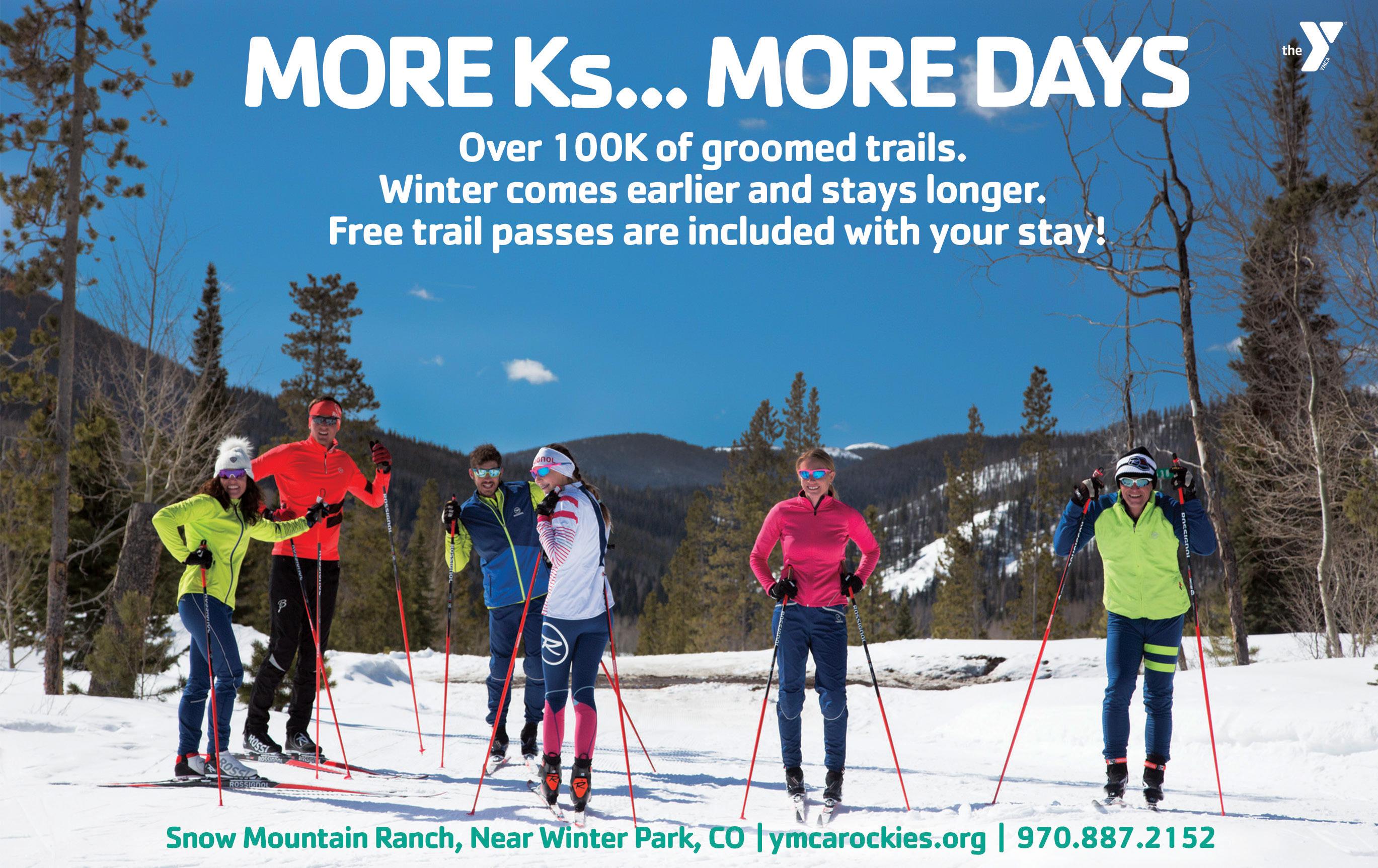
Love wildlife? Head to Estes Park Center. While wildlife viewing opportunities are abundant across both properties, Estes Park is an iconic Colorado locale to spot elk, deer, and birds along trails and right outside lodging windows. The resort also offers wildlife ecology classes and expert guides to help guests safely view wildlife on hikes. And new this year at the Estes Park Center, the Enger Family Nature Trail features an upper and lower loop built for all ages and accessibility levels—the perfect spot for a winter hike or snowshoe.
A key component of the Y’s mission is to provide opportunities to unplug and connect to nature and each other.
Estes Park Center and Snow Mountain Ranch provide the perfect basecamp for your winter adventures.
From on-site snow tubing to cross-country skiing and new winter hikes to guided snowshoe trips in Rocky Mountain National Park, YMCA of the Rockies is a great basecamp for northern Colorado winter adventures.
Big Adventure
If ice skating, sledding and alpine skiing are on your winter to-do list, the Y’s Snow Mountain Ranch location will provide the perfect backdrop. This 5,100-acre low-key “resort” offers easy access to Winter Park

Lessons
The Snow Mountain Ranch Nordic Center offers private and group lessons, as well as Nordic ski equipment rentals for the whole family, including skiequipped chariots for hauling your littlest elves.
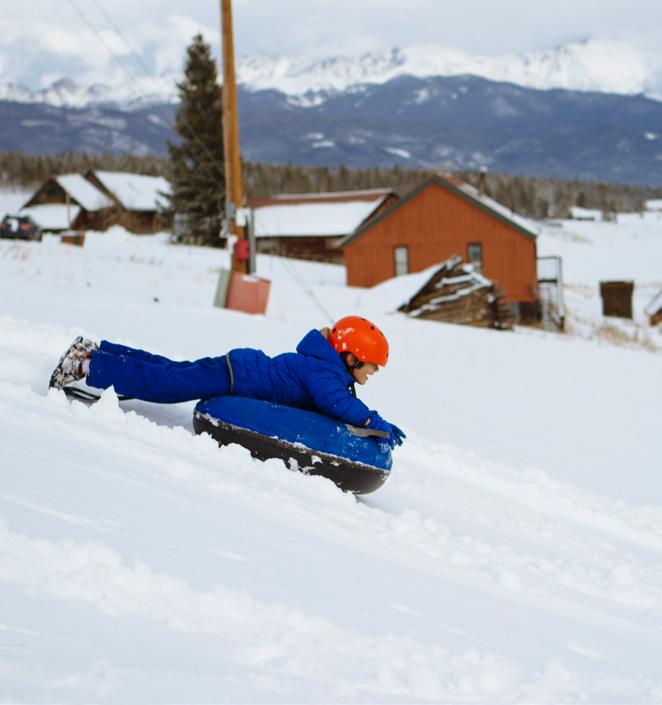
Family Friendly
While both YMCA locations are great, the Estes Park Center is the place to go for allages indoor fun to offset your outdoor fun. Featuring a 35-foot-tall climbing wall, cozy fireplaces available across the property, well-appointed history museum, roller rink, craft center, gym and game room, the possibilities are endless for indoor fun to complement your outdoor adventures!
Lodging
Estes Park Center and Snow Mountain Ranch offer visitors year-round access to iconic Colorado views and cozy accommodations. From hotel-style lodge rooms to multi-bedroom private cabins, affordable lodging options are available at both locations. Most lodge rooms and cabins do not have televisions, providing a truly unplugged experience.
The cabins and lodge rooms at Snow Mountain Ranch are ski-in/ski-out or in walking distance from Nordic ski, snowshoe and fat biking trails. And if you love bringing your furry family members along for the winter fun, you’re in luck, as most cabins at both properties are petfriendly.
PARK CENTER AND SNOW MOUNTAIN RANCH—YMCA OF THE ROCKIES OFFERS UP TOP-NOTCH PROGRAMMING FOR THE 2022–23 WINTER SEASON THAT YOU WILL HELP YOU MAKE THE MOST OF WINTER.
ymcarockies.org ymcarockies @snowmountainranch
by JILL ADLER
The creators of the2010 film Hot Tub Time Machine were definitely onto something in the category of skiing. A hard day of shredding with friends followed by serious soaking, a fine drink, and some beautiful people to ogle—fight me if that isn’t the perfect winter après cliche.
But what if all that was second fiddle to pain relief, rejuvenation, and healing? Substitute the chlorinated swill of your condo hot tub for the natural mineral hot spring water that decorates many of the mountains surrounding your favorite resorts, and you just may find something more intriguing than cleavage and beer… the fountain of youth.
According to Dr. Marcus Coplin, a primary care naturopathic medical doctor, and director of hydrothermal medicine for the Balneology Association of North America, the thermal water found in hot springs—buoyed by minerals like zinc, iron, manganese, fluoride, silica, and magnesium—not only acts as an anti-inflammatory pain reliever but an immune and circulation stimulating catalyst.
“No one drug can give you the benefit that you can get from a 20-minute soak in thermal mineral water,” says Coplin, who has taken up residency in Pagosa Springs, Colorado, as the new medical director at The Springs Resort. “Activating so many different biological pathways all at the same time creates an amplified effect on the body. [Soak] again and again and again and it re-regulates the body’s defenses. The benefits are cumulative.”

The Springs Resort in southwestern Colorado has been around since the 1950s when it was first The Springs Inn, a retreat for weary road travelers, and later a haven for “hippie dippers” in the 1970s. More recently, however, The Springs Resort and Spa has embraced the science of hydrothermal wellness.

Coplin and the resort team have found a way to tell a holistic story that puts “hot tubbing” front and center of a winter day instead of where it currently sits: as the naughty little brother. Printed handouts tell day visitors and hotel guests how to best use the pools for therapeutic soaking, detox, and even sleep improvement. There is also a free guided “contrast bathing” (warrior plunge) experience that starts with soaking in 100+ degree water to open your blood vessels and increase oxygen-rich blood flow to your organs, tissues, and toes, and then stepping into the 40-degree San Juan River to shock your blood vessels and force blood to your core and internal organs, which will help push toxins from your system. Coplin says the constriction also passively exercises your smooth muscles and blood vessels to encourage their elasticity.
Further, hotel guests can also participate in aqua yoga, sound baths, mud baths, guided meditation, and a gratitude ceremony around the Mother Spring–the deepest geothermal pool in the world–which seeds its 25 offspring around the property.
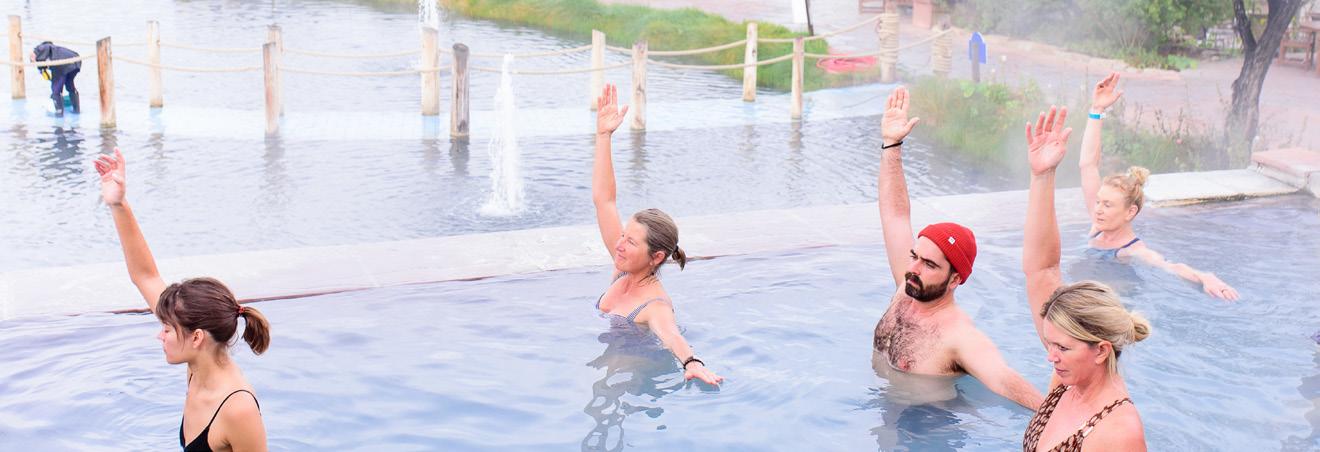
You may have ventured to Pagosa Springs to ski the deep at Wolf Creek this winter, but be careful if you stay at The Springs Resort. As soon as you check in, you will struggle to wear anything other than your robe and bathing suit. Plus, as Hot Tub Time Machine made evident, there really is no better feeling after a robust winter day than being with fine friends while shrouded in the misty steam of thermal waters—or, yeah, sitting in a hot tub.
STAY
Featuring 79 rooms and suites that come with 24-hour access to its 25 hot pots, daily wellness activities, and unlimited robes and towels, The Springs Resort and Spa is ski bum nirvana. Splurge on the Magnesium Muscle Melt treatment for an unforgettable scrub and massage that incorporates one of the most potent elements for tension relief and energy generation. pagosahotsprings.com
SKI
Colorado’s consistently deepest skiing is located just 23 miles east of Pagosa Springs. Wolf Creek Resort sees more average annual snowfall than any other ski area in Colorado (430 fluffy inches) and yet the place has remained understated and authentic. The relaxed pace, prices, and inbounds terrain keep families returning annually,
and the steep-and-deep goods keep the faithful coming back. The place to be on a powder day is the Alberta lift, which accesses 1,000 acres of steeps, trees, and stashes. But it’s the hiking that’s the real highlight here: Bonanza Bowl , accessed from the top of the Treasure Chair, is barely a hike and pays big dividends. Horseshoe Bowl is a much longer hike from the top of the Alberta Chair, but well worth the effort and a good place to hunt for freshies post-storm. wolfcreekski.com

EAT
The Springs Resort hosts a casual cafe for morning crepes and acai bowls and the Barefoot Grille (no reservations or shoes required FYI) for healthy salads and burgers. For something more memorable, take a short drive to the Ole Miner’s (oleminers.com) steakhouse set in an historical-themed ranch house/mine or the sophisticated Alley House Grille (alleyhousegrille. com). Don’t miss the margs and shrimp tacos with wicked-hot habanero sauce at Kip’s Grill and Cantina ( kipsgrill.com).
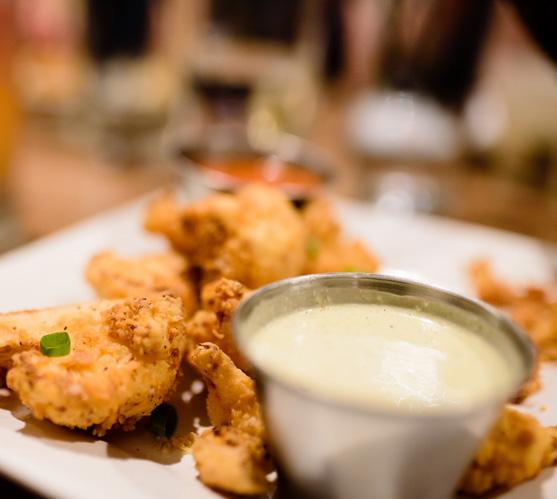
CULTURE
Come back during May 15 through Sept. 30, when you can join a guided hike at Chimney Rock National Monument to visit the homes of ancestral Puebloans and learn about their culture, as well as that of the Ute people. After all, these are their ancestral lands. chimneyrockco.org
WINTER 2022–23 / ELEVATIONOUTDOORS.COM 17
HOT SPOT | 12.22
TIME PAGOSA SPRINGS COMBINES SERIOUS SOAKING CULTURE AND GOOD EATS WITH DEEP POWDER AND UNCROWDED TRAILS. WHERE ARE YOU? CLOCWISE FROM TOP LEFT: WHITNEY LEWIS PHOTOGRAPHY (X4), CHRISTI BODE COURTESY OF WOLF CREEK SKI AREA
PERFECTION: A PAGOSA ROAD TRIP PAIRS SOAKING WITH WOLF CREEK POWDER.
TUB
BEING RUBY J
AN ARTIST, A PROFESSIONAL MOUNTAIN BIKER, AND NOW A PROFESSIONAL SKIER, BROOKLYN BELL HAS BEEN OUT HERE. IN THE FILM BECOMING RUBY J , SHE CREATED A BLACK FEMME CHARACTER TO LIVE UP TO—NOW SHE IS LIVING THAT LIFE.

 by ENDRIA RICHARDSON photos by MATTHEW ROEBKE
by ENDRIA RICHARDSON photos by MATTHEW ROEBKE
Ifirst came across one of Brooklyn Bell’s designs at Color the Crag, a climbing festival for people of color in Alabama, back in 2019. A climber wore a long-sleeved white T-shirt with a person’s face done up in purple line work: full lips; chunky climbing-nut earrings; and thick full hair that swooped up, contoured and lined into a range of granite mountains.
I thought immediately of the stone eaters in Black science fiction and fantasy writer N.K. Jemisin’s
The Broken Earth trilogy. Stone eaters are made of alabaster, antimony, syenite—in short, they are made of durable brilliant stone.
to the fullest extent of her ability within them.
"
What is clear, studying the curving, flowing lines and distinct colorways of Bell’s art, watching her in her elements—leaning into muddy, gnarly single track or shredding pillows in the Alaskan backcountry—is that Bell is an agent of change and transformation. She is shaping and reshaping herself, and remaking the world of big outdoor sports as she does so. She imagines the lines she wants to travel, and then fills them in with herself, hoping and trusting that other Black and Brown people will be able to more easily follow where she’s led.
Their unique strength (literally made of stone) allows them to be agents of change and transformation; they physically remake the fictional world of The Broken Earth Bell had designed the shirt the previous year for Brown Girls Climb, an organization that provides mentorship, resources, and support for climbers of color. At that point, Bell was a professional mountain biker studying graphic design at Western Washington University and already working on design collaborations with Sego Ski Company and Kona Bikes. Over the next few years, she would debut a number of short films, most notably Becoming Ruby J with Patagonia and The Approach with The North Face. Both films showcase Bell’s philosophy, the hard edge she must bring to both worlds in order to move
You’re an artist, a professional mountain biker, and a professional skier. Can you tell us about where you’re from—who are your people and places? My dad ran a hot dog stand at the Seattle stadium, so I would go down there and help him when I was little. My family are entrepreneurs and they are self-made; I guess American. I would spend a lot of time outside, playing outside, climbing trees, and collecting frogs. (I wanted to be a frog scientist back then. That was my dream!)
My parents had property in south Seattle that had a pond and apple, pear, and cherry trees. So I spent a lot of time outside. My parents would put me to work all the time. One of my chores was gathering pine cones and raking leaves; there was always something to be done in the yard. And even though it’s a city, it’s filled with a lot of parks and green spaces; I think that’s one reason why a lot of people like living in Seattle.
Now, I live in Bellingham,
Washington, in the Pacific Northwest. It is kind of as northwest as you can get without crossing the border, close to Seattle and Canada. When I moved to Bellingham, things were a lot closer. I would walk to things—my friend’s house down the street, or to the park, or to Walgreens. You don’t have to drive. Being able to walk places gave me a lot of freedom in my middle school years.
It’s still rare to see Black and Brown people as professional athletes— especially in sports like mountain biking and skiing. In fact, one of your films, Becoming Ruby J is about how you had to create a character (Ruby J is a Black femme professional skier) to look up to. How did you get into both sports competitively and professionally? For me, the drive has always been for progression. I think people think they need to be perfect to show up, and that’s not the reality. There is so much potential in people who want to become professional skiers and mountain bikers, who want to be part of this space. And the truth is, power and privilege and access really makes a difference.
Before I started mountain biking, I was working at a bagel shop, and
I was also running. Every single day after working at the bagel shop, I’d go running at our local mountain bike hill. There was a regular who would come into the bagel shop every day. He’d order the same bialy and black coffee—it was funny because I didn’t know his name or anything about him, but I would serve him the same thing every morning—and then I’d run into him at the mountain bike hill.
ELEVATION OUTDOORS / WINTER 2022–23 18
STRAIGHT TALK | 12.22
THERE IS SO MUCH POTENTIAL IN PEOPLE WHO WANT TO BECOME PROFESSIONAL SKIERS AND MOUNTAIN BIKERS, AND WANT TO BE PART OF THIS SPACE. AND THE TRUTH IS, POWER AND PRIVILEGE AND ACCESS REALLY MAKE A DIFFERENCE.
One day, he was like, “I keep seeing you here running. Why aren’t you on a bike?” I said I didn’t know if I could afford a bike. And he was like, “I’ve got an extra bike, let’s go riding.” I loved it.
It’s pretty simple. It’s not necessarily that certain people are more athletic, or ballsy, or risky, or better at things. It’s just... who actually gets to have the opportunity to go on these trips, try these things, and get exposure? People who have more resources and more access to space get better.
When I first started getting support for mountain biking, I didn’t feel like I deserved it, or was a good rider. But in the past couple of years—because I’ve had access to better bikes, food, and clothing—I’ve progressed a ton. It’s because I’ve had more support. So I was like, maybe the same thing can happen with skiing.


[When I first started skiing], I got invited to shoot on a trip. I got to ride my first set of “pillow stacks” [when snow stacks on top of a boulder, and can be skied or jumped off]. I was exposed to other professional skiers. They let us ride pretty challenging terrain. And I was like, [sponsorships] could be a cool avenue to learn to be a better skier.
Since The Approach film took us [Bell, Emilé Zynobia, Vasu Sojitra, Anna Soens, and others] to Alaska, I’ve progressed. Now, I show up from a place of joy versus putting pressure on myself to beat something, which I think really helps me be able to ski better. I’ve been able to recognize what equipment is really helpful for me. I think I understand and lean into what my style of skiing is, and I am able to identify what my progression looks like on any day. I have a better mental map of how to ski, where to put my turns, and how to put down a line. All of that just comes with time and experience.
I think most people would be like, “two Black women and disabled folks in Alaska? You know...we’ll see if they can progress from there. Probably not.” But the truth is, when we got that opportunity, we took it and ran with it.
For The Approach film, you were able to go up to Alaska and spend a lot of time with other Black and Asian skiers. What needs to change in the outdoor industry to break down barriers for Black kids and other people of color to start skiing? There are so many different factors. Of course, resources and being able to get a ride to the mountain are big barriers. Transportation is a big overlooked factor. Even if you have the money to buy a pass and skis, you might not have the money to buy a four-wheeler. I spent a lot of years hitchhiking to the mountains. It wasn’t until the last couple years that I actually had a car that was capable
of making it. I relied on other people for rides.
Then, the culture itself is white. It’s based on limited space. If you’re there on a powder day, there’s only enough powder for some people. It’s also a culture of looking perfect and looking cool. There is a lot the culture of skiing can do to be more welcoming and create more space for people to be themselves. I don’t necessarily think all Black and Brown people are poor. That’s not always the case for access. There is a cultural piece. For example, in these white mountain towns, there is this culture of “you can be a dirtbag; you don’t need a safety net; you can spend all your money on skiing.” But culturally, a lot of Black and Brown people see that as a really big risk—selling all your things and buying a ski pass and having that be your path.
The industry could also invest more money in people. The Approach is proof of concept. If you actually give people the opportunity to go to these places and ski, they might actually get better. More companies could put more resources into people being able to try things.
There are a lot of diversity, equity, and inclusion initiatives happening. There is a ton of interest in Black and Brown people in the skiing space.
More companies could do more to listen and say, “We want to help you develop”—helping people with ski passes and helping with resources, instead of just putting people on billboards or ads for lifestyle stuff.
You’ve mentioned you love having a team and a community of people with whom to ski. What inspired you to join Faction? What do you love about the Faction team?
Faction felt natural to me. A big draw for me is having a community and not feeling alone. I have friends who really enjoyed their skis, so I bought a set. They were just the most fun skis. Vasu, from The Approach, connected me with them. They sent me a couple of skis and gave me a chance to try them. And it kind of progressed from there.
In my head, I thought, “Sweet, I have enough sponsors on the biking side to help me pay for skiing. I’m not going to worry about being sponsored.” I assumed I wouldn’t be able to get technical sponsorships for hard goods. It’s really special and surreal to actually have that support. I wasn’t really expecting it.
What’s next for you? What are your dreams? In five years, 10? I want to continue filming. I want to become a better skier. I want to hit
more pillows. I really like the idea of having conversations about the culture of skiing and what we can do to change things. I’m hoping in the next five years, we’ll see new conversations about breaking down barriers to skiing—and more people getting sponsored. I would love to collaborate on a design with Faction. I think it would be cool to do a movie that’s all about biking, skiing, and art all in one. It would be cool to retell the story of Ruby J [the cartoon image of a Black femme, professional skier that Bell developed years ago], because I have made a lot of progress as Ruby. That story is so powerful.
When I first came out with Ruby J , people didn’t think I could possibly, in any world, be Ruby. People were like, “Brooklyn’s going to do all this work with DEI, and the next generation will have a Ruby.”
And I was like, “No, I am Ruby. I want to be a big mountain skier.”
Now... it would be great to tell that story.
WINTER 2022–23 / ELEVATIONOUTDOORS.COM 19
SILVERTHORNE, COLORADO
Explore the heart of Summit County and discover where art meets adventure. Enjoy Nordic skiing and snowshoe trails, ice skating and sledding, see a show at the Silverthorne Performing Arts Center, or attend a signature First Friday event. Find your next adventure in Silverthorne!



ELEVATION OUTDOORS / WINTER 2022–23 20
SILVERTHORNE.ORG
Back to Breath
WHEN CHRIS KASSAR’S SISTER DIED OF CANCER, GRIEF THREATENED TO PARALYZE HER. THEN SHE DECIDED TO TAKE ON THE GRAND TRAVERSE SKI RACE—WITHOUT KNOWING IF OR HOW IT WOULD HELP.
 by CHRIS KASSAR
by CHRIS KASSAR
APRIL 3, 2022. INHALE, REACH. Exhale, glide. Cold air in, reach. Warm breath out, glide.
Tiny metal angel wings clipped to my pack keep rhythm as they clink against a sparkly wooden angel ornament inscribed with “Love Never Dies.”
Looking up for the first time in hours, I marvel at the line of headlamps snaking through endless switchbacks above, the first inkling of dawn illuminating a violet sky overhead.
It’s 5:41 a.m., and we have already reached the Upper Brush Creek Checkpoint. Can that be right? My husband, Ryan, and I have been climbing uphill on skis since midnight. Time and distance are a complete blur.
“Look,” I whisper, motioning uphill with my chin so I don’t slow down. “We may actually do this.”
I’m verbalizing a thought I haven’t allowed to cross my mind since we
first hatched this whole crazy idea in the fall.
“Hell, yeah,” he says. “Lots of climbing left. Keep crushing.” With those encouraging words, Ryan effortlessly begins the steepest climb of the race.
He’s right. We’re 15.5 miles into the Grand Traverse, a 40-mile ski race from Crested Butte to Aspen, and at the top of this 1.75-mile, 1,300-foot climb is Starr Pass, the last timed checkpoint. We need to be leaving it before 7 a.m. Any later earns us a DNF and a long, sad ski back to Crested Butte.
I settle into an uncomfortable but familiar pace. On the icy skin track, I pass people who are slipping, losing skins, redlining.
I feel alone. I’m struggling to breathe. I’m holding back tears, a state I’ve been in most of the last year since my sister’s diagnosis.
Without warning, I am transported back to Angele’s bedside. Something that’s been happening involuntarily, often at very inopportune times since my oldest sister took her last breath five months ago. A shell of her physical
former self, she’s leaning in and whispering, “You have to know how amazing you are. Why do you always doubt yourself? It’s time to stop. Please do that for me?”
“Ok. I promise. I love you,” I say without thinking. Her words make me feel so seen, understood and deeply full of despair given that one of the people who knows me best and loves me anyway will soon be gone. We hold each other and sob, unable to speak what we both know. The cancerous tumor choking her femoral artery means that soon she will no longer be here in her human form.
A howling wind snaps me back to the skin track. My once sweaty hands scream in frozen pain. Tears freeze in place. I’m falling behind and have lost sight of Ryan. Panic sets in. “How did I ever think we’d actually do this?” Then I hear Angele’s voice. “It’s time to stop.” Moving faster now, I turn the corner and see Ryan waiting for me at the summit. I dig deep, thinking of all she pushed through and crank up my speed to get to the top. We rip skins and cruise down the bumpy slick slope to reach the checkpoint.
“We’ve made it through the hardest part,” I say. But, much like the ups and downs of grief, just when I think I’ve turned a corner or made a move forward, I am inevitably proven wrong.
Less than a mile later, we are stopped. My binding won’t stay engaged. The same happens to Ryan. We flail around, post-holing and wasting energy trying to remedy the situation. Ryan’s a ski tech, so he tells me to take a break and goes to work.
A reel of scenes from the last month of Annie’s life—which I spent in Jersey awkwardly trying to help her family— flashes through my mind. I wasn’t actually much help, but I was there. Foot rubs, brushing hair, watching our fav scenes from Friends, crying for hours while I watched her sleep, trying to decipher what she needed when she yelled out in a pain-med induced language all her own, helping her do things I never thought I’d need to.
Ushering in a steady stream of friends and family there to say goodbye, a testament to the incredible life she lived. Conversations I never thought we’d have: Please help mom and dad smile again; tell the grandbabies
WINTER 2022–23 / ELEVATIONOUTDOORS.COM 21
A NEW DAY: KASSAR'S DYING SISTER INSPIRED HER TO BELIEVE IN HERSELF
MY WHOLE WORLDVIEW—MY PATH AND PURPOSE— HAS BEEN SHAKEN BY THE LOSS OF SOMEONE SO GOOD, SO HONEST, SO IMPORTANT. RAVEN PHOTOGRAPHY
"
ELK
I’m so sorry I couldn’t meet them; make sure Helen (our other incredible sis) starts putting herself first; make sure big Ken (the love of her life) stays healthy; help the kids (Kelley and KJ, her two amazing grown kiddos) remember me as beautiful and fun, not sick like this. Watching my parents witness their first baby fade away—body, mind, then spirit—leaves me without words. I beg a God I’m not sure I even believe in to take me instead. I’m not as needed, will not be as missed, but he doesn’t come through. My heart breaks multiple times a day as I bear witness, alongside my beautiful family, to this incredible woman slipping away from us both too slowly (she’s in so much pain) and too quickly (we’ll never be ready).
Despite it all, every day we get with her is an honor—sharing memories, tears, laughs, and eventually just silence. Then, on a regular Tuesday in November shortly after 9 a.m., she is just gone—seven weeks shy of her 60th birthday.
“ Try to step in,” Ryan says bringing me back to the race. Fail. Still no luck. We are both on our knees messing with our bindings, trying to clear out the ice and snow—exhausted, starving, dehydrated, and wasting time. I think back to how we ended up here. A week after my sister’s last breath, I am back in Colorado. Days spent wandering around the house lost and crying. Nightmares cut from actual scenes of the past year haunt the little sleep I get. Each morning, I remember she is gone and the wound reopens, a
cruel, repetitive joke. Angele lived large and was a total badass. She loved without limit, always putting connection and community first. She was incredibly generous with her time, energy, and abundance. 'Gel' (as the little ones called her) dove headfirst into things that scared her. She never passed up an opportunity for fun, and she remained grateful until the very end. I quickly realize that figuring out how to go on without her will be even tougher than the past year. And not just that, but figuring out how to live a life worthy of being the one who gets to keep on living, that may be the hardest thing I’ll ever do.
Ryan is worried, so I reluctantly agree to go on a ski tour with him and our good friend, Spencer, even though I’d rather just spend another day curled up on the couch.

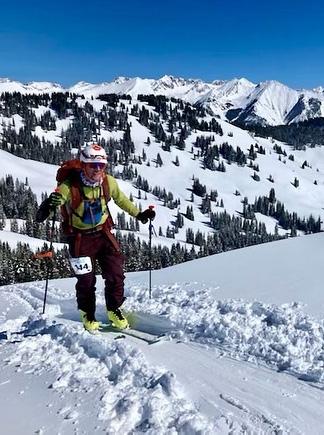
My heavy legs lumber across week-old snow, shattering the serene silence. Inhale. The unfamiliar intensity of my lungs filling up fully almost knocks me over. Exhale. Emptiness.
In this moment, I realize I’ve been holding my breath for months—afraid of each text, each phone call, each new heartbreak. But up here above tree line, I am forced to—allowed to—finally breathe. Tears overcome me. This was a huge mistake. I’m not ready to be here.
Way ahead, the boys are dark silhouettes on a distant ridge. I plod forward, tears streaming down my face. I cry because she will never experience beauty like this again. I cry because I don’t understand why I still get to. I cry because I have never imagined my life without her. I cry because I don’t think I can make it through the next 20 or 30 years without her—and I don’t even want to try. When I catch up to Ryan, he
pulls me close. “Good. That’s what I was hoping. Cry. Cry. I love you.” At a time when I have no idea what I need, Ryan somehow knows exactly.
We rip skins. Waves of blue mountains stretch out before us in the fading winter sun. I flail on rubbery legs that haven’t been used enough the last couple months. I fall often and when I’m actually upright, I wobble through turns like a newborn deer rather than a seasoned backcountry adventurer. Our yellow Lab, Nala, bunny-hops next to me. I feel a palpable but tiny lift in my heart. All thoughts of misdiagnosis, chemo, radiation, immunotherapy, what ifs, whys, shouldhaves, fears, and regrets disappear. The corners of my mouth curve up slightly. My first smile. Then a rush of guilt for what feels like a betrayal. The moment is over, but I immediately know I need more of these moments if I’m going to survive this.

Later that night, a recurring nightmare cut from an actual scene of Angele’s last month wakes me; TV, meditation, medication, Nala cuddles, reading. Nothing works. Then, lying in the dark, eyes closed, I am back on the skin track. Labored breathing, heavy legs, awkward turns, one pure but fleeting moment of peace. It’s the first glimpse I’ve had of the “real me” in ages.
I never fall asleep, but instead start researching a longtime dream; something I’ve been too scared to try until now. “Did you sleep at all?” Ryan asks when I get into bed to cuddle at first light. “It doesn’t matter. Let’s do the Grand Traverse,” I say. Barely awake, he says “OK.” I’d expect nothing less from my adventure and life partner, this man who oozes love for me and has more confidence in me than I do.
The moment the idea is made real by telling Ryan,
ELEVATION OUTDOORS / WINTER 2022–23 22
MAKING THE CUT: KASSAR AND HUSBAND RYAN TRAINED FOR WEEKS TO TAKE ON THE RACE. ELK
RAVEN PHOTOGRAPHY
I want to take it back. We can’t do this. We’ve never even tried skinny skis, or raced at all, or gone further than 10 miles on skis, or (insert multiple other fears and doubts). I hear Angele’s words “Why do you doubt yourself? It’s time to stop.”


I have to push fear aside and try for her. But, really, I know it’s for me. My whole worldview—my path and purpose—has been shaken by the loss of someone so good, so honest, so important. I am questioning everything, especially the point of it all. I need something that gives me a point, that tethers me to life—otherwise, I feel like I will float away. And in the past, when things have gotten tough, snowy mountain adventures where I lose myself by pushing my body, mind, and spirit to new heights have always helped me find myself again.
Over the next few months, we get all new gear and train our asses off. As we cover mile after mile, climb up and over countless new passes, and explore new terrain, tackling peaks and long, vast valleys, the highs and lows mimic my grief. We fight a lot and get lost more than once. We share tears of accomplishment, sadness, and fear. We raise over $5,000 for cancer research, and we learn how to haul ass downhill—not very gracefully—on skis the size of toothpicks. We lose multiple toenails and most of the skin off the bottom of our feet while we discover a depth to our determination and love that surprises even us. I feel like myself for more and more moments in the mountains, but sometimes returning home feels even more painful as the reality of life without her stretches before me.
Race day comes and we are ready—beyond ready. But now, here on this slope, fighting with our bindings,
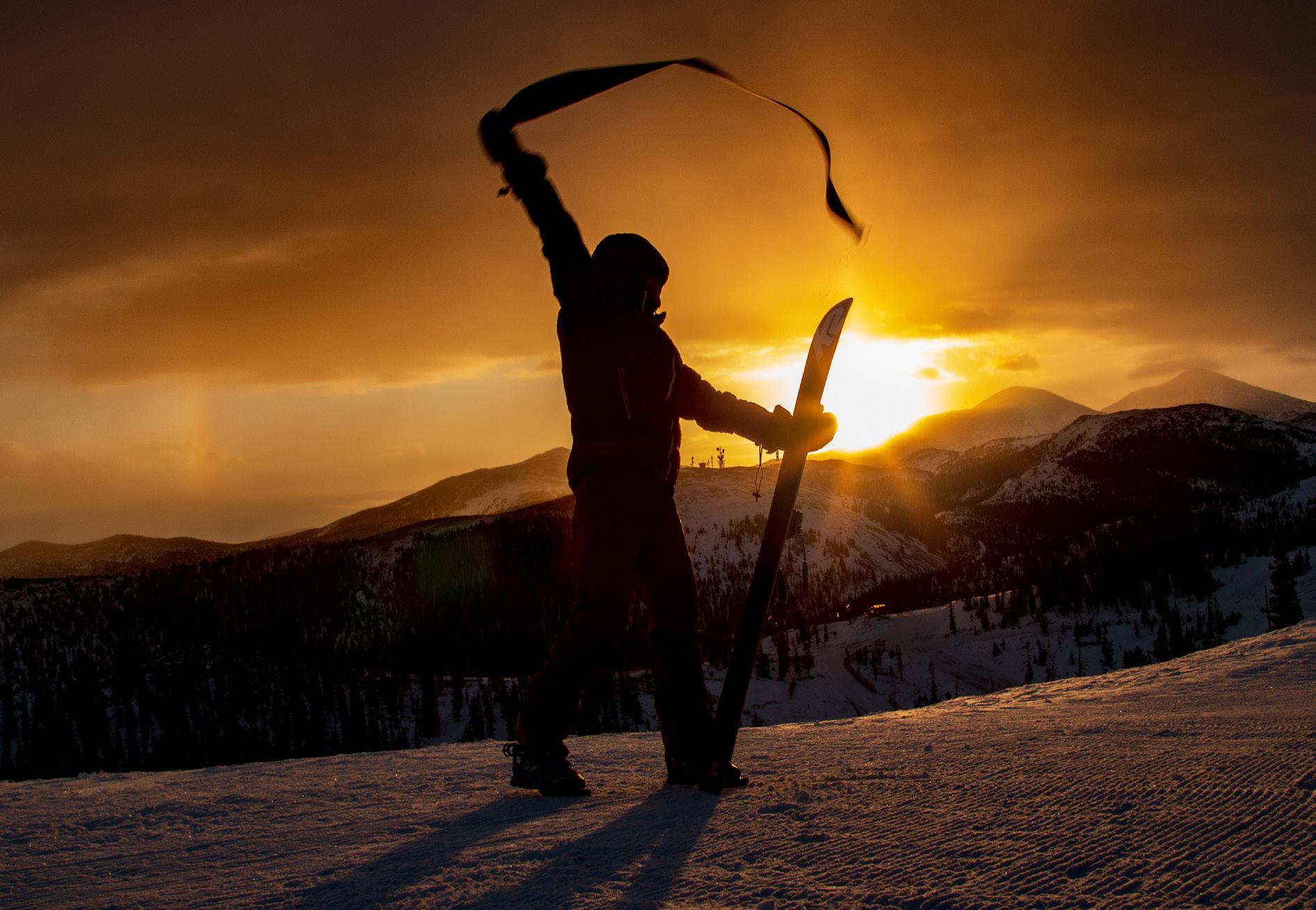
I feel crazy to think we could ever do this race. In this moment, I start asking her for help. I guess I start praying to my sister to get us out of this jam.
Click! The sweet sound. After 90 minutes, we are on our way. At least 100 people have passed us and we are way at the back, but it doesn’t matter. I’m not skiing for time or a medal or to beat any other skier; I’m out here because, without this race to get up for everyday, I’m not sure I’d even still be here.

Soon, we break into Richmond Ridge, a grueling rolling section too flat to skin, but with enough ups that skating is a challenge. Supposedly it is stunning, but today we are in a snow globe that someone keeps shaking. Unable to see more than a few feet ahead, we have no perspective on our progress. We move up, then down, and up again. Time is passing, but it all looks the same, much like grieving for me. I am exhausted. My legs shuffle rather than glide, and the bottom of my feet are peeling off with each step. I consider lying down and just giving up. But the thought flies away on the wind when I think of one of our very last talks.
I am lightly holding Angele’s hand. It’s cold and so very thin. She is sleeping, or so I think. “I’m so sorry, sis,” I say through a wall of tears, “for all you’ve been through—so much pain, so many hospitals, so much bullshit.” She snaps to, looks me directly in the eye and speaks a fierce truth. “This isn’t bullshit, sweetie. This is the most important thing I’ll ever do.”
And then, she is asleep again. Even after months of being bedridden and fighting a disease she ultimately couldn’t beat, she kept believing she had important things to do—goodbyes, imparting wisdom, preparing
to transition to whatever comes next, and saying “I love you,” as often as she could—even when she could barely form coherent words anymore.
She never quit—on herself or on any of us—so how could I even consider it?
Finally, we begin the long, sweet descent down Aspen Mountain. Ryan waits for me a couple hundred feet above the finish line so we can cross together. As I stand there looking down on the last bit of the race, rather than being relieved, I am scared for what awaits. Skiing 40 miles seems easy compared to figuring out how to carry on without my sis, how to live a life worthy of being the one who gets to.
As I make my la st swoosh down the slope, I feel the purest form of joy, a feeling floating over snow always brings. I allow a tiny smile to come in. I am painfully aware that finishing won’t bring my sister back. But perhaps, by chance, it will bring back a tiny piece of me, and that’s a start she’d be proud of, at least.
Author’s Note: Without this race—this commitment I’d made to Ryan, to myself, to my family, to all the people who donated to cancer research—I’m honestly not sure I’d still be here. Thank you for all who supported our efforts, including Crested Butte Nordic, the Limelight, Elevation Hotel & Spa, Dynafit, CAMP USA, Rab, Matt Lanning for all the coaching, Spencer Hereford and Frankie Block for being our awesome shuttle team, Kay for putting us up in CB so often, and all the other racers for a humbling experience. You can still donate to the Cancer League of Colorado in honor of our “Angel with an “E”, here: cancerleague. app .neoncrm.com/ourangelwithane
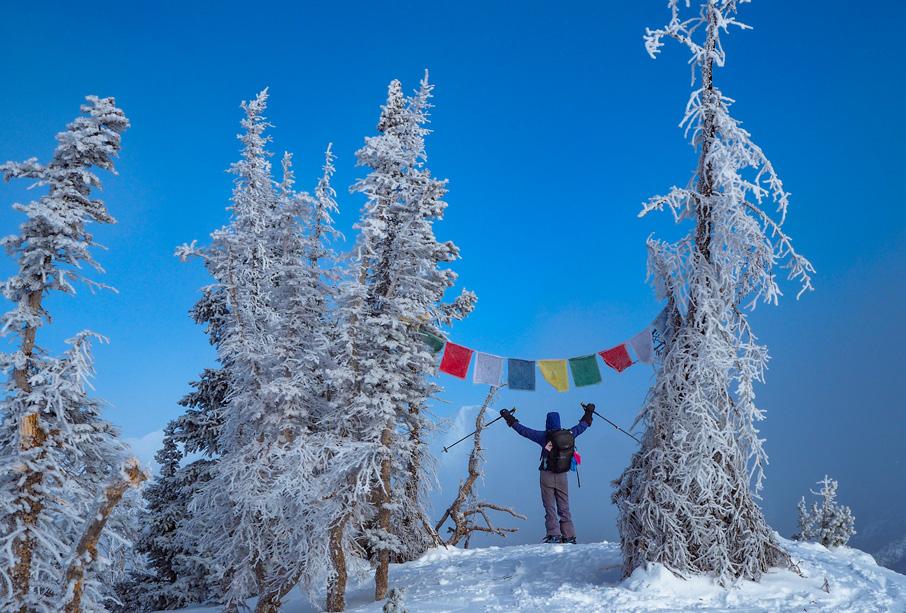
WINTER 2022–23 / ELEVATIONOUTDOORS.COM 23
RAVEN PHOTOGRAPHY
ELK
GO DEEP
by DOUG SCHNITZSPAHN
1. Dynafit Free 107
Dynafit has built its reputation with skis that excel when it comes to touring, but the Free 107 breaks new ground. Measuring in at 135/107/125 mm in a 185 cm ski, it’s a big powerful board that boogies up the skin track and provides plenty of confidence in deep snow. A poplar wood core beefed up with carbon stringers makes it snappy and reliable no matter the terrain, and tip and tail rocker give it outstanding float—as well as the ability to snap off quick turns. $750; dynafit.com

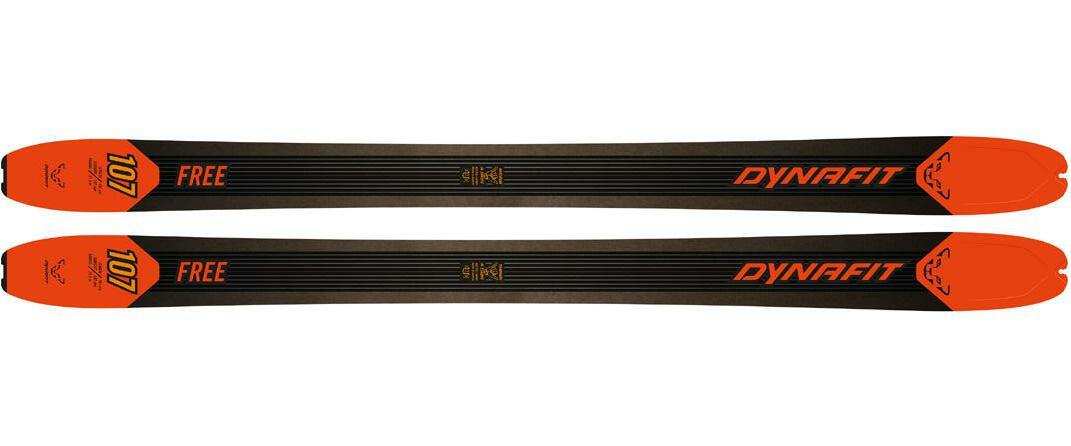
2. Dynafit Radical Pro
The best boot we have put to the test over days of touring and resort laps, the Radical Pro works with pin, frame, and hybrid bindings. Utilizing the brand’s Hoji Lock System, which engages with one easy flip that battens the boot down from comfy touring mode to dialed-in ski mode, the boot handles both going up and bombing down with precision while tipping the scales at just over 3 pounds in a size 26.5. Best of all, it comes with a lifetime guarantee. $800; dynafit.com

3. Jones
Ultra Stratos Split
Jeremy Jones is the evangelist of “shralpinism” (see page 10) and this light all-terrain splitboard is the perfect tool for heading deep into the wild—or running hiking laps at your local hill. With narrow sidecut and directional rocker, it can edge but also elevates in deep snow. Weighing just under 6 pounds in a 159 cm length, it’s as smooth as skis on the skin track. Best of all, the Karakoram Tip Lock Tip Clips and Karakoram 3C Clips system makes it easy to tour and simple to join it back together for stable performance on big lines. $1,700; jonessnowboards.com
4. Flylow
Baker Perm Bib
Lightweight, breathable, able to shuck off bad weather, and built with sustainable materials, this trusty bib is going to be your new day-to-day best friend. Plus, it never rides down your waist when you are skinning up the hill. $520; flylowgear.com
5. Backcountry Access Float
7. Sweet Protection Ascender MIPS
Avalanche Airbag and T3 Avalanche Rescue Package
E2-35
We can’t preach enough when it comes to safety in the backcountry. Gear is useless without knowledge, experience, and sound judgment, but it’s also essential to have equipment that could save your life if something goes wrong. With an improved compression system and the ability to carry it along for air travel, the latest version of the Float can bring you to the surface if you do set off a slide. Beyond that, it’s a roomy pack that can haul all the essentials for big backcountry objectives. But you need more. The all-in-one T3 package includes BCA’s Tracker3 avalanche transceiver, B-1 EXT avalanche shovel, and Stealth 270 avalanche probe— mandatory gear at a price lower than buying it all separately. It’s ideal for those just venturing into backcountry exploration as well as anyone looking to upgrade their kit. With the airbag— and training—it will improve your odds should you ever run into trouble. $1,300 airbag, $435 rescue package; backcountryaccess.com
6. Black Diamond Recon LT Stretch Shell


Giving you plenty of three-layer waterproofing to keep out the elements but still breathable, light (17 ounces), and offering up the stretch you want when you are schussing uphill, this durable jacket is our choice for any day in the backcountry. $385; blackdiamondequipment.com

You wear a helmet all the time at the resort and you should in the backcountry as well. The problem, of course, comes down to bulk and weight. You can’t use those excuses here. This protective lid (the MIPS technology will mitigate concussions) weighs just over 15 ounces, doesn’t get in the way when you attach it to your pack for the skin up, and provides plenty of ventilation. It’s ideal (and certified) for everything from resort laps to ski mountaineering. $220; sweetprotection.com
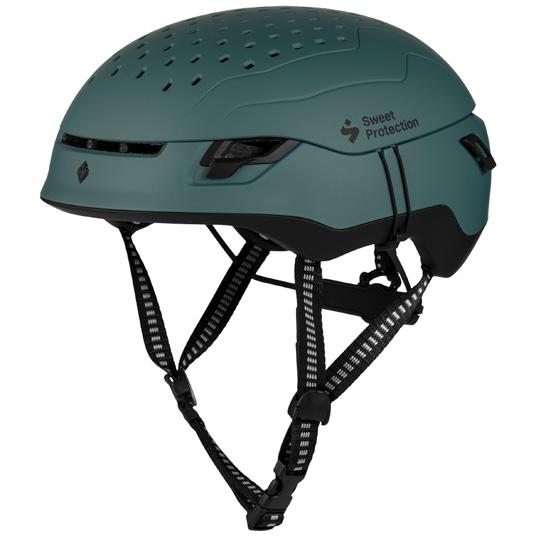
8. Leki Guide Lite 2
Adjustable between 110–145 cm, this high-strength aluminum backcountry ski pole can handle all the rigors of touring and wild terrain. Plus, it’s comfortable in your hand thanks to the Aergon Air grip system that feels comfy in your hand. Bonus points: The powder basket is also designed to clean snow buildup off your skins. $130; leki.com

ELEVATION OUTDOORS / WINTER 2022–23 24
BACKCOUNTRY GEAR | 12.22
IT’S SHAPING UP TO BE AN INCREDIBLE SNOW YEAR ACROSS THE WEST. HERE’S THE BEST NEW EQUIPMENT THAT WILL HELP YOU ENJOY THE UNTRACKED AND STAY SAFE IN THE BACKCOUNTRY.
1 6 2 5
8 4 7
IT’S TIME TO HAND OUT OUR COVETED HARDWARE TO THE BEST STUFF WE PUT TO THE TEST OUT IN THE WILD—AND KEEP USING EVERY DAY.
Völkl/Marker
Rise Beyond 96 ski/ Kingpin 10 bindings $750; voelkl.com/$600; markerbindings.com
WHY IT WON: This slick setup proved perfect no matter where we toured. The big skis levitated in the deep stuff, smashed through garbage snow, and schussed like smaller sticks on the skin track—but what impressed us most was how nimble and responsive they were for a powder ski, darting through the trees and even edging well when we rode them in area.
Paired with Marker’s latest iteration of the trusty Kingpin AT binding, it’s the perfect do-it-all set up for big lines and soft snow in the backountry.
WHERE WE TOOK IT: Indian Peaks backcountry, Jones Pass, Berthoud Pass, and Eldora in Colorado; Jackson Hole and Teton Pass in Wyoming
Dalbello
excellent for steep climbs. A full length boot board kept our feet warm even in bitter early morning cold uphilling at Eldora. We were a bit suspect of how it would perform on the downhill, but pleasantly surprised by how well it drove skis in a wide range of conditions. Note: The top-ofthe-line men’s Dalbello Quantum Evo ($1,000)—which provides even more ski-driving power and comfort on the skin up, and which we also tested and now use day-to-day—is pictured in the photo above.
WHERE WE TOOK IT: Edora, Winter Park Resort, the Indian Peaks backcountry, and Jones Pass in Colorado; Jackson Hole, Wyoming; Sun Valley, Idaho
Patagonia
R1 Air Zip-neck $119; patagonia.com

Twice each year, we hand out these coveted Peak Gear Awards to the very best gear we put to the test in the field. How do we determine the winners? Simple. We ask our top contributors—who, we are proud to admit, spend far more time skiing, riding, skinning, biking, climbing, and exploring than they do “working”—to name the best gear they used over the past year. What gear can’t you live without? Which gear changed your life? What products made your adventures better?

Quantum Free 105 W $800; dalbello.it
WHY IT WON: Weighing under 3 pounds in a women’s size 23.5, this is the lightest touring boot we have ever owned and also the stiffest and most dependable in manky snow. On the uphill, a dual link cuff provides a 65-degree range of motion—good for flats and semisteep skinning but
WHY IT WON: Slip this soft warm fleece on and you won’t want to take it off. It simply feels good to the touch—beyond all the impressive insulating and breathable properties. Plus, it comes from a company that puts values over profit.
WHERE WE TOOK IT: Skiing all over Colorado as a baselayer; car camping; sitting at home doing the crossword on a lazy Sunday morning
WINTER 2022–23 / ELEVATIONOUTDOORS.COM 25
THE BEST | 12.22
Contributors: AARON BIBLE, ROB COPPOLILLO, LIAM DORAN, CHRIS KASSAR, RADHA MARCUM, CAMERON MARTINDELL, ARIELLA NARDIZZI, TRACY ROSS, RYAN MICHELLE SCAVO, DOUG SCHNITZSPAHN
THE WINTER 2023 PEAK GEAR AWARDS
PHOTOGRAPHY
ANDREW KORNYLAK
Romp Leif 94
$949; rompskis.com

WHY IT WON: Light, fast, and able to whip quick turns in any conditions. These skis, which measure 132/94/122, upped our game whether we were touring or charging downhill. On top of all that performance, the graphics stand out compared to other skis on the track, and they are made right here in Crested Butte, Colorado.
WHERE WE TOOK IT: Berthoud Pass and the Crested Butte backcountry; Eldora and A-Basin uphill skiing
Solo Stove Bonfire 2.0
$400; solostove.com

WHY IT WON: We have tested a multitude of portable fire pits, but none of them are as comfortable to sit around as the Bonfire 2.0. The key is the smokeless design which means you don’t have to keep shifting your seat. It’s easy to transport but still looks great on your deck.
WHERE WE TOOK IT: Car camping across Colorado, New Mexico, and Utah; our own dam backyard
Teva
ReEmber Terrain Slippers

$90; teva.com
WHY IT WON: These two-for-one slippers aren't just ultracomfy and warm—they're rugged enough for a quick approach to the nearest crag. They have outstanding traction and the closed heel makes them quite comfortable and stable. Plus, the outer material is water-resistant for cold, dewy mornings.
WHERE WE TOOK IT: Everywhere— from the high peaks of the San Juans to cragging in Clear Creek Canyon
Voormi
Sportsman’s Two
Pocket hoodie
$329; voormi.com
WHY IT WON: Made with a tight outer weave, this cozy hoodie is also incredibly durable, and the fleece-lined interior is warm and comfortable against the skin. But what really sold us is the integrated membrane that cuts the wind and makes this a must-have for cold-weather outings, whether we were active or just hanging out.

WHERE WE TOOK IT: Winter adventures across the West from Sun Valley, Idaho, to Jackson, Wyoming
Rab Kinetic Alpine 2.0 Jacket

$295; rab.equipment
WHY IT WON: Sure, it's waterproof, the cut is performance-oriented and comfy, and it breathes—but the really cool thing about this fully waterproof/ breathable jacket is that it's quiet and soft, like a soft shell. It is our go-to hard shell no matter the endeavor.
WHERE WE TOOK IT: The summit of Mont Blanc and a ridge traverse of the Entrèves in the Alps; ski touring in Canada; the works
Stio Hardscrabble Insulated Mitt
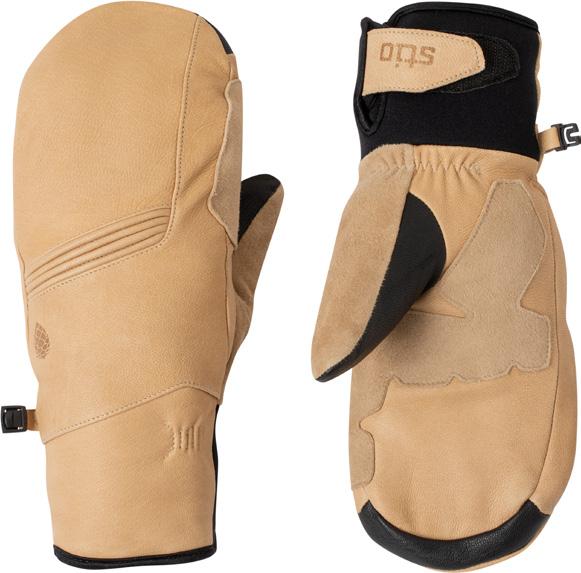
$159; stio.com
WHY IT WON: This is the softest mitt we have ever worn. Made of Pittards goatskin leather with a suede wrapped palm and Neoprene cuff and filled with PrimaLoft 3-oz. insulation, they stay supple when temperatures drop. It comes in unizex sizing
WHERE WE TOOK IT: Aspen, Eldora, Winter Park Resort, the Indian Peaks backcountry, Jones Pass
ELEVATION OUTDOORS / WINTER 2022–23 26
Atomic
Hawx Ultra 130 S GW $975; atomic.com

WHY IT WON: This is the ultimate in-bounds ski boot. The fit is spot on, and the aggressive flex pattern is perfect for the all mountain ripper. It’s quite light and super responsive—exactly what you want in a day-to-day hillbanger.

WHERE WE TOOK IT: Resorts all over the western U.S. and Canada.
Atomic Bent Jr.
$335–$425; atomic.com
WHY IT WON: Twin tips and fun graphics are really all it takes for my 8-year-old to get excited about skis since she loves to goof around and ski backwards. But the Bent Jr. is more than that—these kid’s skis are easy to maneuver, stable, and help little ones gain confidence on the slopes. Plus, they ring in at a nice price with bindings included.
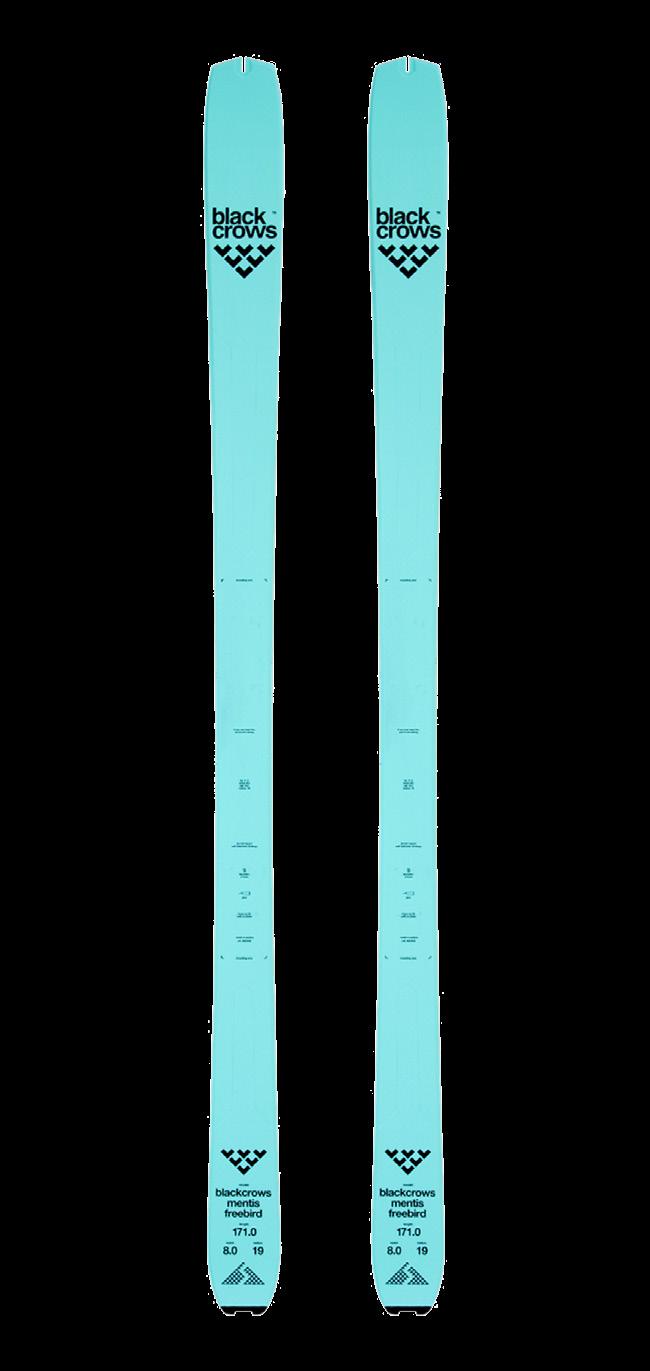
WHERE WE TOOK IT: Eldora, Colorado; Jackson Hole, Wyoming
Leki Patrol 3D Glove

$130; leki.com
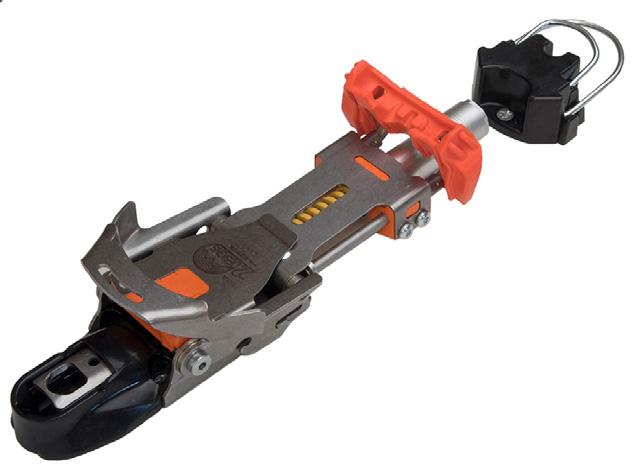
WHY IT WON: Leki is best known for making great poles, but its gloves are world-class too. Ideal for both backcountry touring and in-bounds skiing, the Patrol 3D features a lowprofile cuff that makes getting our jacket over it much easier.
WHERE WE TOOK IT: Resorts and backcountry all over the western U.S. and Canada
Artilect
M-Divide Stretch
Fusion Hoodie $380; artilect.studio
WHY IT WON: Up-and-coming Boulderbased brand, Artilect wowed us by combining mobility, ethical down, waterresistance, durability, and other technical and environmental attributes into this thoughtful and versatile layering piece.
WHERE WE TOOK IT: Mountains throughout the Front Range and Mountain West
Scarpa

Maestrale Remade $749; scapra.com
WHY IT WON: Scarpa’s redesigned Maestrale is already our favorite AT touring boot—light, easy to switch between walk and ski modes, and responsive on the downs. But the brand brought it up a level with this limited edition that is crafted from production scraps that Scarpa has saved in its manufacturing facility for the past two years. The result is a sexy boot that shows how we can build gear and care for the planet.
WHERE WE TOOK IT: Ski demos in Colorado
22
Designs
Outlaw X
$430; twentytwodesigns.com
WHY IT WON: For those of us telemark adherents this binding continues to be a game changer. The NTN system imparts more control and power edge to edge so we can rip the resort, and the easy-toflip-into tour system means we can keep up with anyone when we are skinning.

WHERE WE TOOK IT: Resort and backcountry skiing across Colorado;
Taos, New Mexico; Jackson Hole, Wyoming; Åre, Sweden
Camelbak
SnoBlast 22
$120; camelbak.com

WHY IT WON: It’s important to stay hydrated if you plan to spend an entire day exploring the far reaches of a mountain (think Copper Bowl and Turner Mountain). This well-designed pack keeps your water from freezing but never gets in the way when you are skiing or riding the lifts.
WHERE WE TOOK IT: Eldora, Winter Park, and Copper Mountain
Costa Del Mar Diego
$234; costadelmar.com
WHY IT WON: These are the best sunglasses our mountain guide tester has ever worn in 15 years on the job. They have phenomenal optics, great protection, and scratch-resistance.
WHERE WE TOOK IT: The summit of Mont Blanc in the Alps, rock climbing in Las Vegas, driving cross-country, trailrunning—you name it
Ibex
Wool Aire Hoodie
$285; ibex.com
WHY IT WON: It provides the perfect lightweight warmth for cold(ish) mountain hikes when a regular puffy would feel great to start out but overheats us in 10–15 minutes. With this layer, we don’t have to feel cold to start out, and we are not soaked underneath by the end of the hike.
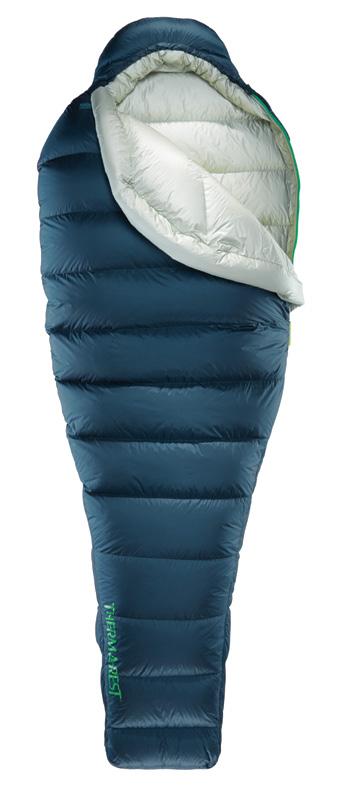


WHERE WE TOOK IT: Hikes and dog walks in Boulder Mountain Parks and Santa Fe’s Dale Ball trails
Thermarest
Hyperion 20
$470–$530; thermarest.com
WHY IT WON: We relied on this cozy (but not too hot) sleeping bag on bikepacking trips through fall and early winter. It’s ultralight and ultrapackable, fitting perfectly into a saddle bag. It also wicked like a champ on a steamy (thanks to the unexpected wood stove!) winter hut trip.
WHERE WE TOOK IT: Bikepacking and hut tripping in the San Juans
OnX
Backcountry App
$30/year; onxmaps.com
WHY IT WON: This navigation app won for the second year in a row because we continue to rely on it. It’s easy to use and full of useful data, including weather, avalanche conditions, and all the other map-app expected features like offline maps and waypoint sharing (via the Somewear sat messenger when off the grid).

WHERE WE TOOK IT: All over the Western United States
Black Crows
Mentis Freebird
$950; black-crows.com
WHY IT WON: Meet the ticket for lightand-fast skiers looking for stability. At 80 mm underfoot, these light, versatile sticks have enough guts to be trustworthy on tricky terrain and speedy on the skin track. Front rocker provides good pivot and floatation, and a long camber imparts extended ski-to-snow grip.
WHERE WE TOOK IT: Eldora, Winter Park Resort, the Indian Peaks backcountry, and Jones Pass
WINTER 2022–23 / ELEVATIONOUTDOORS.COM 27
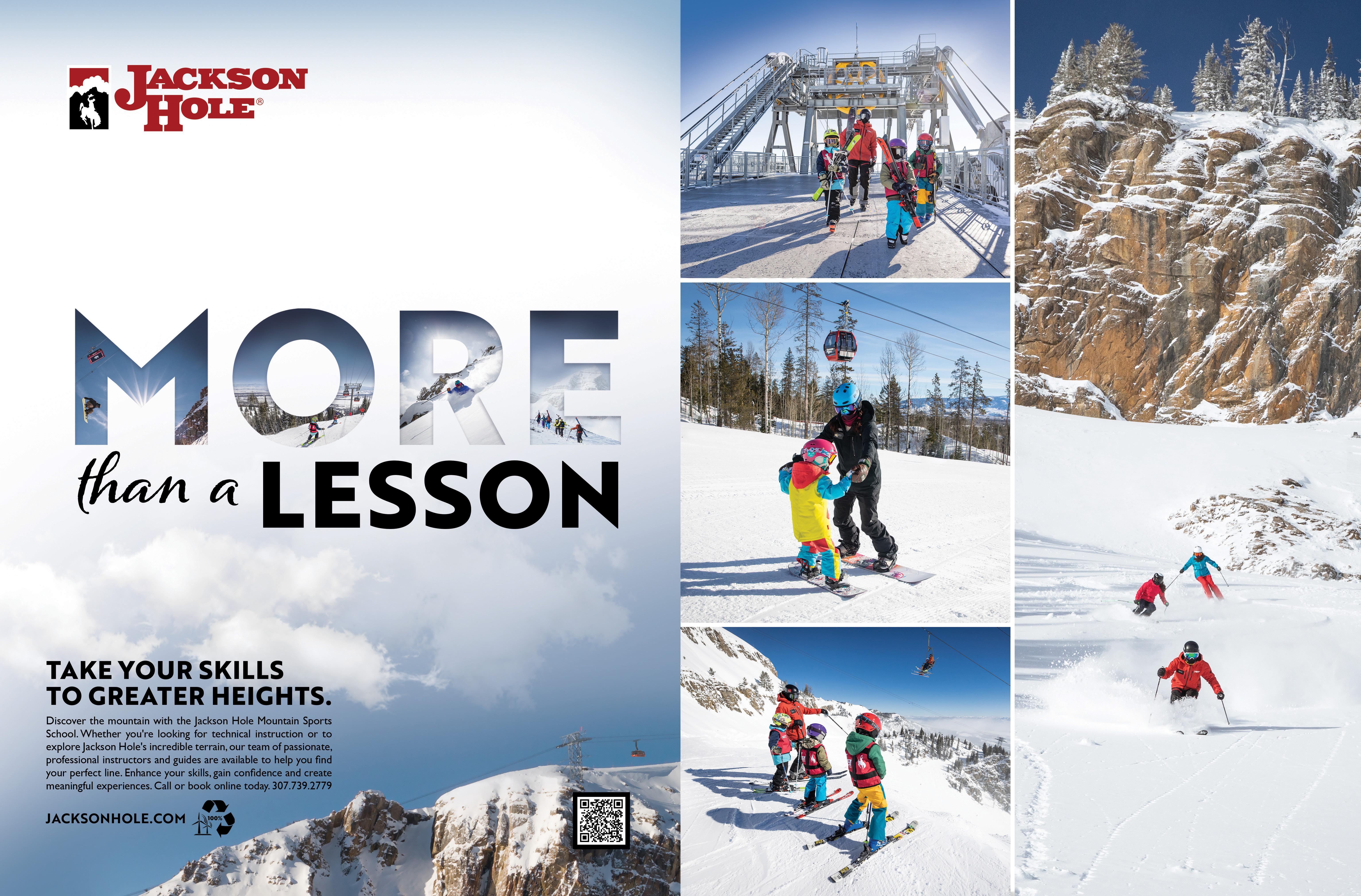

OF SPORT AND WAR
COLORADO’S CAMP HALE IS NOW A NATIONAL MONUMENT, HONORING THE ANCESTRAL LANDS OF THE UTE PEOPLE AND 10TH MOUNTAIN DIVISION SOLDIERS WHO TRAINED HERE BEFORE GIVING THEIR ALL.
by PETER KRAY
DRIVING THE WINDING, HIGH ALPINE road from Red Cliff to Leadville when the long succession of peaks are covered in snow or the aspens are gold in their season, it would be easy to miss the weathered remnants of Camp Hale and its importance to the creation of the 10th Mountain Division, America’s first—and only—mountain troops.
But as children, it seemed to my brother and me that it had been the site of some epic battle for the soul of ski heaven. Here, pioneering expatriate ski instructors, first ascent climbers, and Ivy League outdoorsmen who had trained to go and fight the Germans during the height of World War II had created an unbreakable bond of sport and ultimate sacrifice. The proof of it was in the pure blue sky above us, the barrack remnants, and the found shell casings rattling around in our pockets.
The fact that so many 10th Mountain veterans were still alive, hiking and skiing the same peaks and slopes, never occurred to us at the time. Because so many of their victories and accomplishments had already become the stuff of myth.
On Oct. 12,
President Joe Biden formally acknowledged the national significance of the small city they occupied at 9,200 feet from 1942 until it was decommissioned in 1945 when he signed a proclamation establishing the Camp Hale-Continental Divide National Monument. In his first use of the Antiquities Act to create a new national monument, Biden recognized
this storied Colorado landscape’s deep importance to the history of the Ute Indian Tribe, and also to the training of the 10th.
As Biden’s press release announcing the designation says, “The rugged landscape of Camp Hale–Continental Divide serves as a testament to a pivotal moment in America’s military history, as these peaks and valleys forged the elite soldiers of the famed 10th Mountain Division—the Army’s first and only mountain infantry division— that helped liberate Europe in World War II. The area lies within the ancestral homelands of the Ute Tribes, along the Continental Divide in north-central Colorado, and is treasured for its historical and spiritual significance, stunning geological features, abundant recreation opportunities, and rare wildlife and plants. The area’s mountains and valleys also shaped our modern outdoor recreation economy, which today supports millions of American jobs.”
It’s appropriate—albeit somewhat saccharine—flowery praise for a division that suffered significant casualties, including 3,134 wounded in action, 38 missing, and 992 confirmed dead.
As I wrote of the 10th in my novel The God of Skiing, “In Italy they fought like hell to take Belvedere and Riva Ridge from the Nazis when no one thought they could be taken—after full battalions of allied troops had tried for months already to take them. They advanced in the dark, scaling the bare vertical stones of Riva with their ropes and rifles, or sliding through mud and fog toward Belvedere as grenades and bullets rained down in the morning. Champion ski jumper Torger Tokle was one of the hundreds killed. Friedl Pfeifer, the godfather of Aspen, spent the rest of his life with German metal inside him.
“Those that survived, like Pete Seibert, Bob Parker, David Brower, Paul Petzoldt and Bob Dole, came home and spread like messiah’s to America’s mountains. They built its ski resorts, its politics and environmental ethics, and the world’s new standards and methods for ski instruction.”
In Santa Fe once, I sat down with Parker himself. “If you are skiing, you are living,” he told me, tearing up as he remembered the names of his comrades who never came back home.
With Seibert, Parker built Vail. He skied the open-run wonder of the Back Bowls— tilted pastures and knolls of new snow under a sky so blue it felt as if you
were under the ocean—before anyone. And he went back to Riva Ridge 50 years after its surrender to climb with the same Germans who woke to bayonets moving like hot knives through the mists in the morning. It was in the spirit of the hills—the friends who were gone and a shared love for the mountains.
Parker told me General Klenhart, who had commanded the German defense, cried when he looked down the impenetrable rock face where the 10th had bet the sharp tip of their assault. “It is not possible,” he said.
“But general,” a German veteran replied. “It happened.”
And any time after that whenever I saw a veteran of the 10th at some ski industry event, where they were rightly lauded for all their contributions and sacrifice, I made a point of walking up and shaking their hand and thanking them.
They always responded with a smiling, “It was nothing,” kind of demeanor, and often something to evoke a laugh. I remember in Vail at Ski Industry Week, I met two 10th vets at the back of the breakfast buffet queue and asked, “Is this the end of the line?”
“It was,” they laughed, looking over their shoulders at me riding caboose. A joke I realized at the time was 60 years in the making. Here’s to being grateful for the recognition of a place that brought life and outdoor community to so many generations. We offer our unending thanks.
—Elevation Outdoors editor-at-large Peter Kray is the author of the God of Skiing. The book has been called “the greatest ski novel of all time.” It's the perfect read for a visit to Camp Hale. Buy it here and read it now: amzn.to/35AfxlL

ELEVATION OUTDOORS / WINTER 2022–23 30
ELWAYVILLE | 12.22 ILLUSTRATION BY KEVIN HOWDESHELL/THEBRAVEUNION.COM
THOSE THAT SURVIVED, LIKE PETE SEIBERT, BOB PARKER, DAVID BROWER, PAUL PETZOLDT AND BOB DOLE, CAME HOME AND SPREAD LIKE MESSIAH’S TO AMERICA’S MOUNTAINS.”
"

KHROMA
Expertly balancing protection and performance, the Khroma range is for those who dream big and ski hard. Engineered for self-propelled backcountry skiers and dedicated ski mountaineers, Khroma is equipped for everything from steep ascents, to technical couloirs and exposed faces.


WWW.RAB.EQUIPMENT





































 PATROL 3D
Photo: Grant Gundeson
PATROL 3D
Photo: Grant Gundeson

 —Sarah Kuta
—Sarah Kuta






















 by ENDRIA RICHARDSON photos by MATTHEW ROEBKE
by ENDRIA RICHARDSON photos by MATTHEW ROEBKE





 by CHRIS KASSAR
by CHRIS KASSAR








































